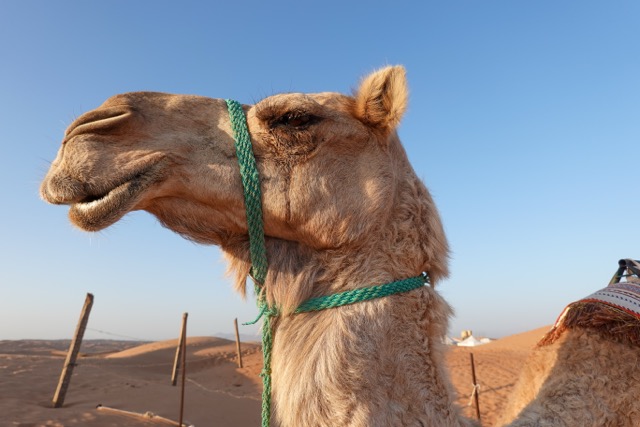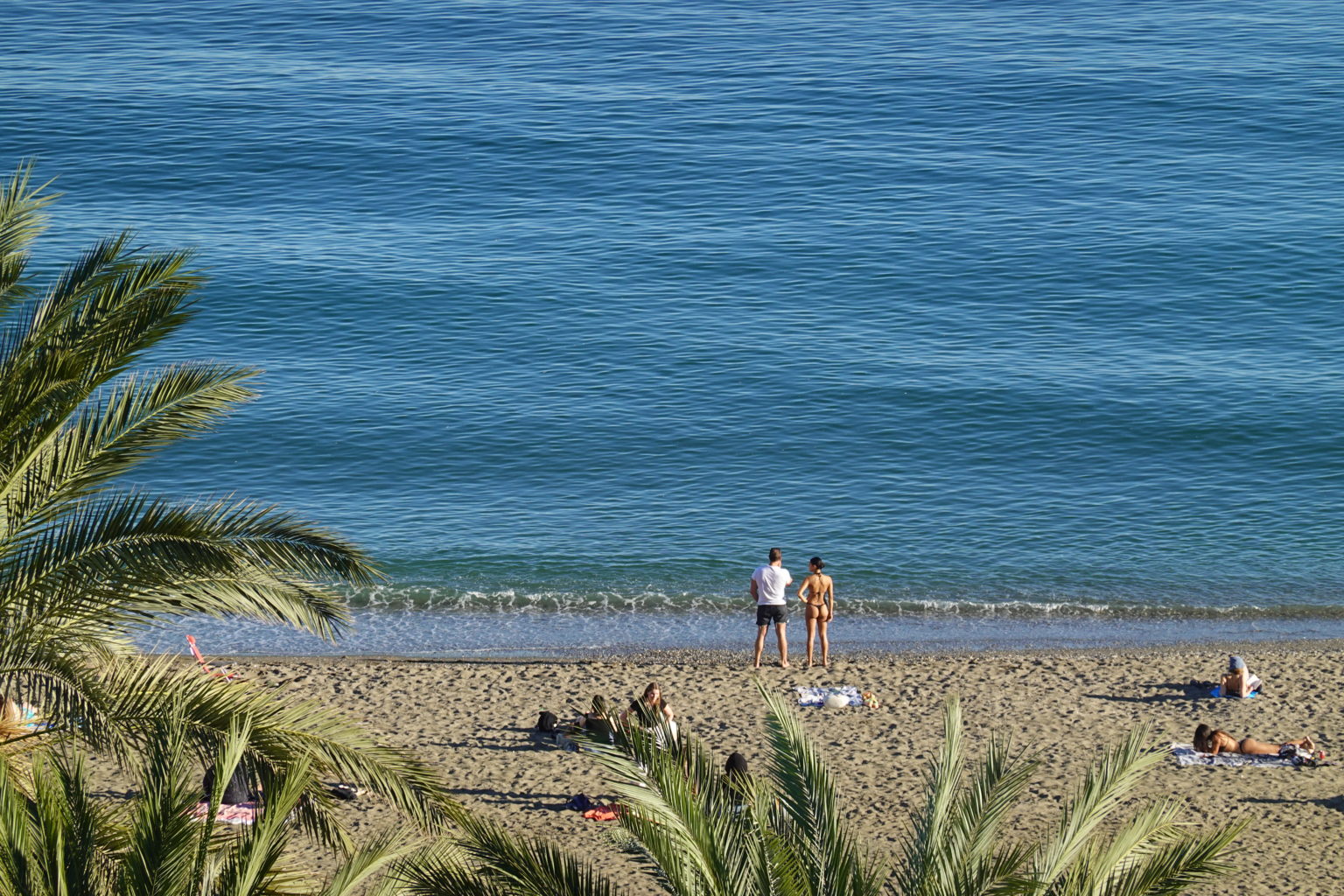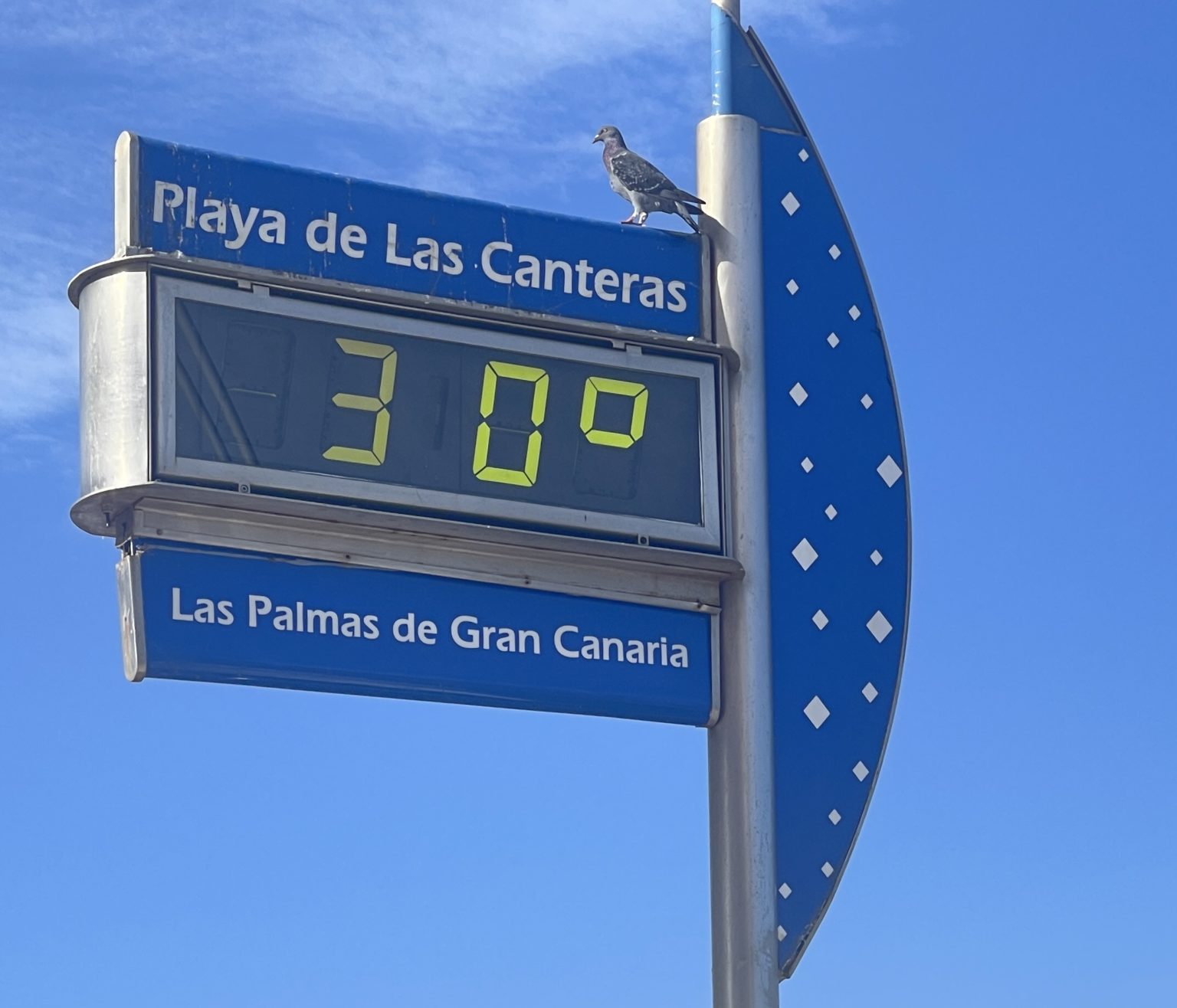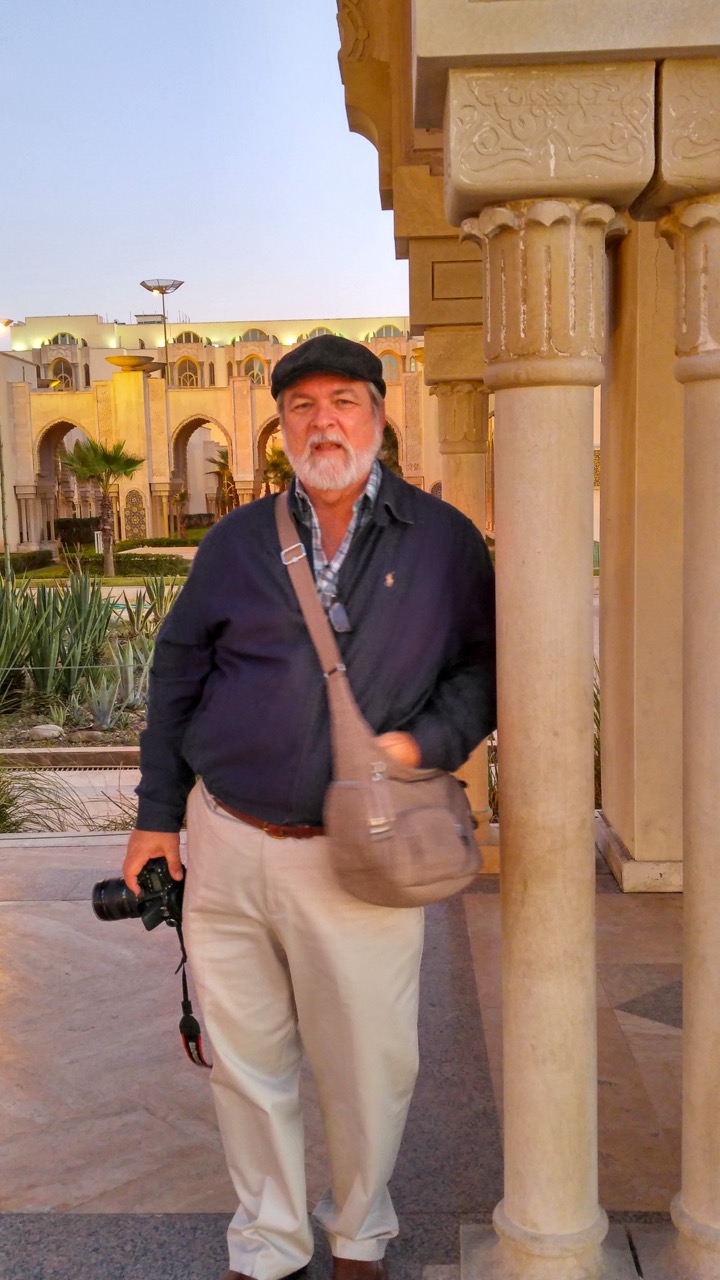Oman’s Natural Beauty
An antidote
A gentle breeze softly stirred the fine, dry sand and swirled it across the slight ridge of the dune where I sat soaking up the last of the day. The colors around me were gradually warming and the silence seemed to deepen as the sun continued its inexorable, slow descent toward the endless sea of desert stretched out before me. Here was a moment to be fully present, engaged with the beauty of nature. Here is why I had come to the Arabian Peninsula.
It’s hard to put into words the depths of our grieving in the weeks leading up to this moment. Like many of you, Bonnie and I have watched the beginning of a systematic and deliberate destruction of all that we have cherished and believed to be right about our country. It is utterly heartbreaking. The stress, anxiety, and uncertainty about our own future nearly led us to abandon this trip. Thankfully, we did not.
The natural world extends us an invitation: be fully present – savor my beauty – feel your place in the vastness – find perspective – soothe your despair. Oman gave us a chance to accept this invitation. It is a land of stunningly diverse landscapes that seem to speak of origins and eternity. Our immersion was far too brief.
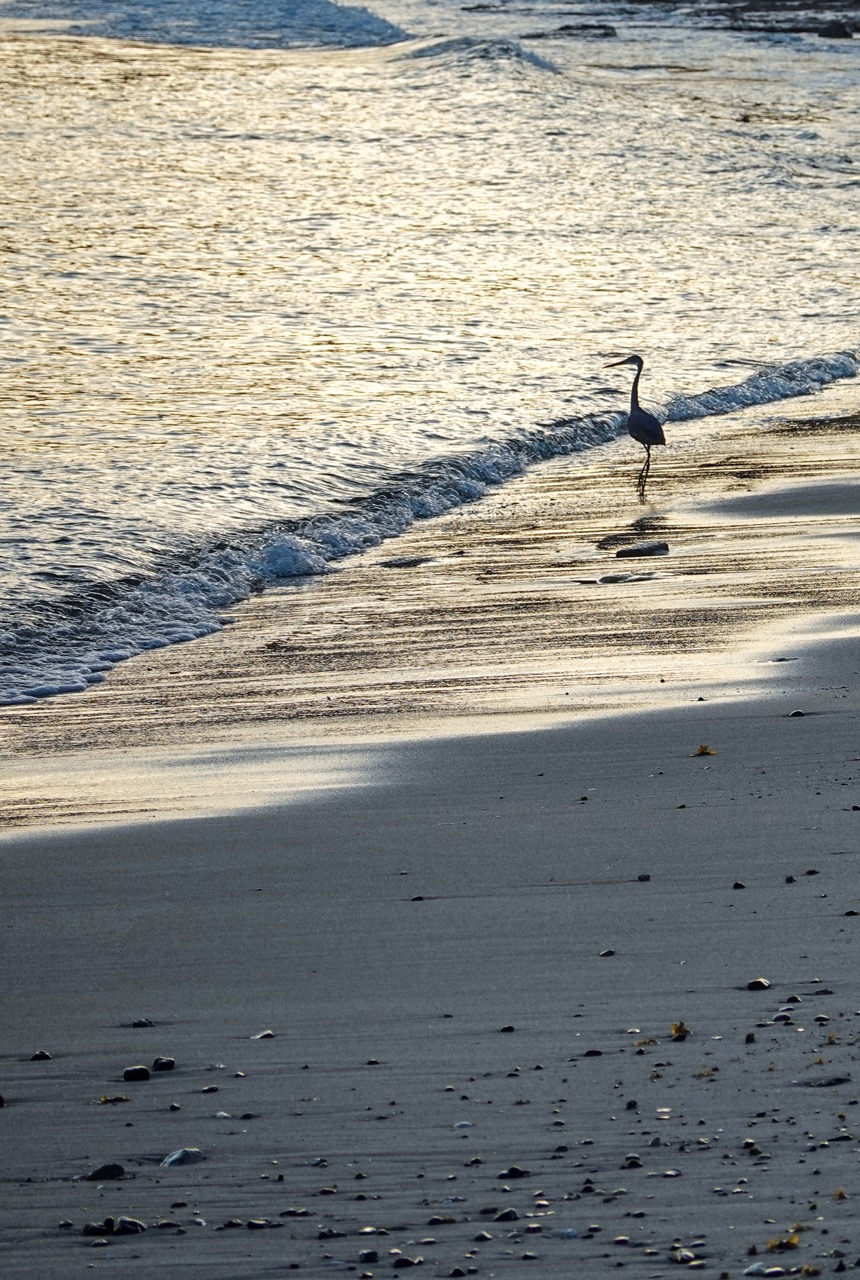
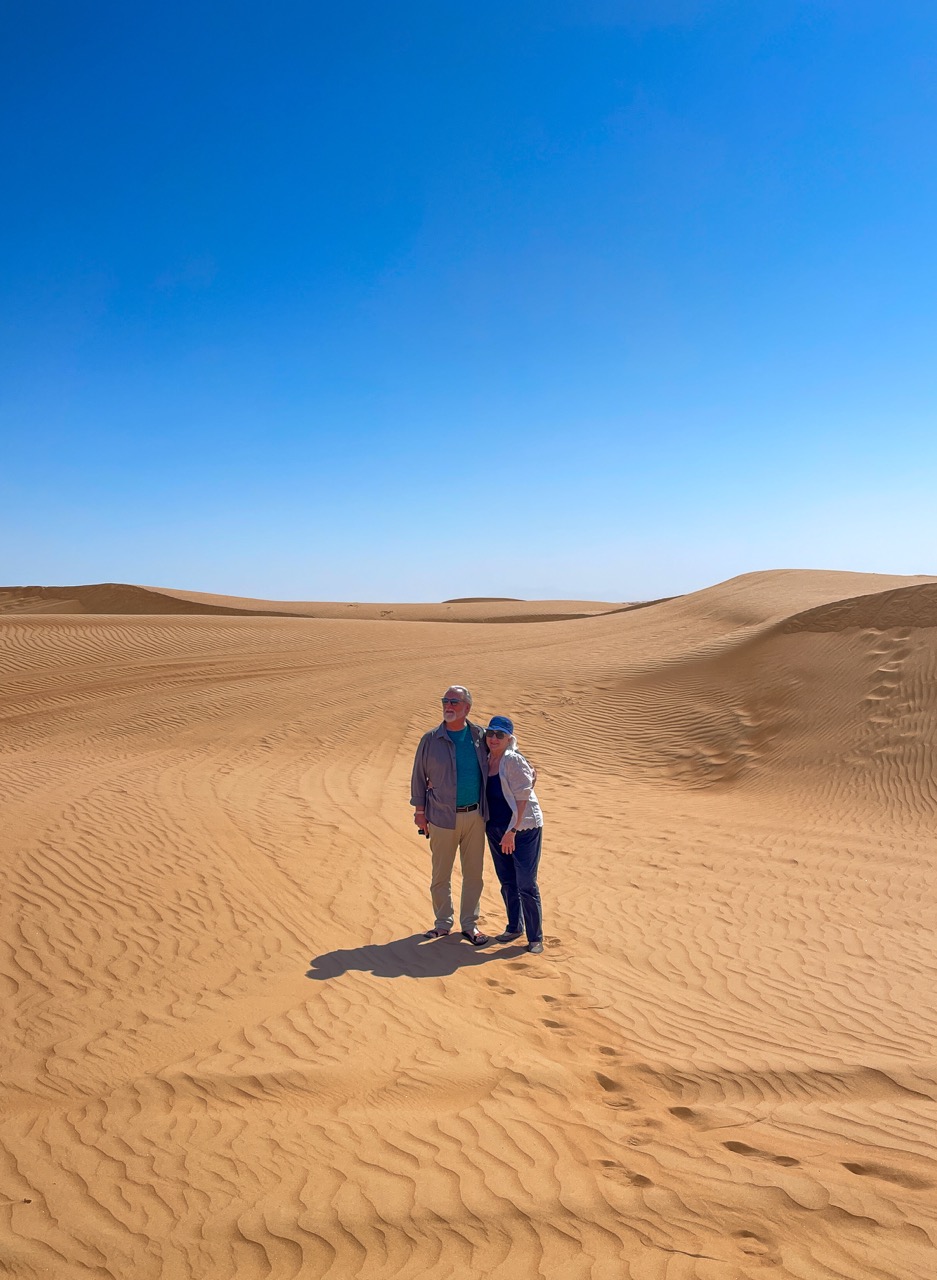
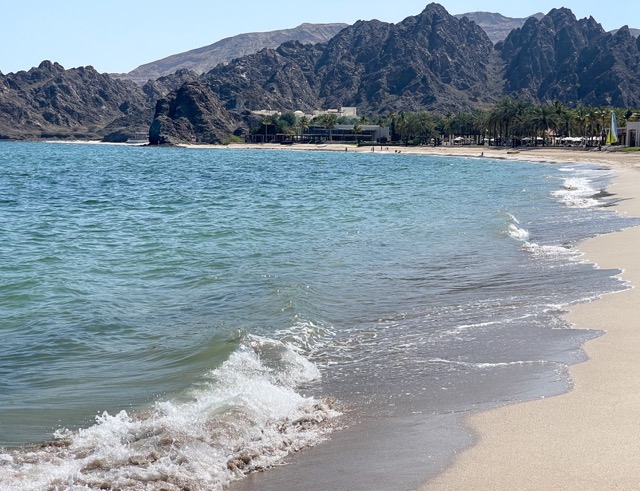
The planning for this visit began with a mandate to find a warm escape from winters’ frost. This is an annual event in our household but took on added urgency this year with the approach of one of those round number birthdays. Oman sprang to mind – warm, unknown, exotic maybe. Bonnie had never been to the Middle East, and it had been more than forty years for me. It was an impulsive . . sure, why not . . kind of decision. Once again, as has so often happened in our travels, the experience was richer and more compelling than anticipated. We are learning to be open to new experiences and embrace the surprises that come along as we travel. This trip certainly included a few:
- The emotional impact of watching a 300-pound greenback turtle trudge through the sand, laboring to dig an enormous hole to bury her precious cargo of fertile eggs.
- The cleanliness of a desert landscape almost entire made up of sand.
- Spectacularly jagged mountains and great yawning canyons with a geological character unique on the planet.
- The crystalline, aqua waters of the Arabian Sea, teaming with life in quantities I haven’t seen since the good-ol’-days in Baja.
- Our own preconceptions and prejudices needing a major update.
Long Before Us . . . there were Turtles
After unpacking and settling into one of the twelve “Eco-Tents” at Ras al-Jinz Turtle Reserve, we eagerly awaited the 8:30 PM gathering time for the short trek to the beach in the hopes of seeing sea turtles lay their eggs. Oman is home to some of the most important turtle nesting grounds in the world and Ras al-Jinz is famous for its endangered green turtles. The turtles return, after 20 to 30 years of growth, to the very beach where they were hatched. It was not peak season, and we heard that the previous night did not produce any turtles. Sea turtles come ashore under the cover of darkness and typically avoid the beach at full moon and, yep, the moon was nearly full that night.
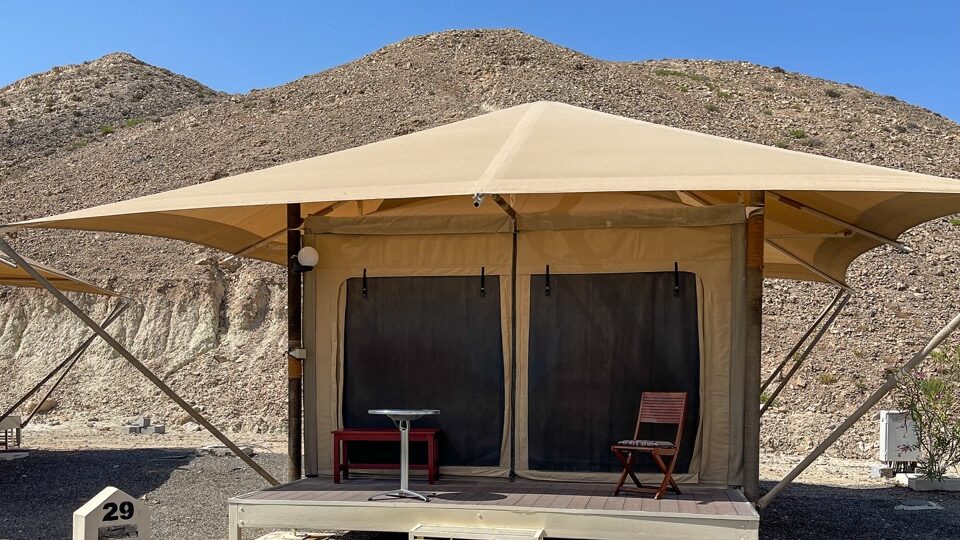
We gathered with other hopeful souls at the designated time, only to be told to wait. The staff was combing the 4-kilometer beach but could not report good news yet. Finally, at about 10PM we were hurried into a van which deposited us on the protected beach. The sea sparkled under a bright moon that led us a hundred yards up the beach where we were stunned to encounter a hatchling just a few hours old. We had hoped to see a mother attempting to lay eggs, but a hatchling was completely unexpected! At about 2 inches long, she struggled over the sand, straining with the all-consuming need to reach the ocean. As we stood in awestruck silence, I became aware of the tears streaming down Bonnie’s face and gently wrapped my arms around her while we shared this miracle of nature.
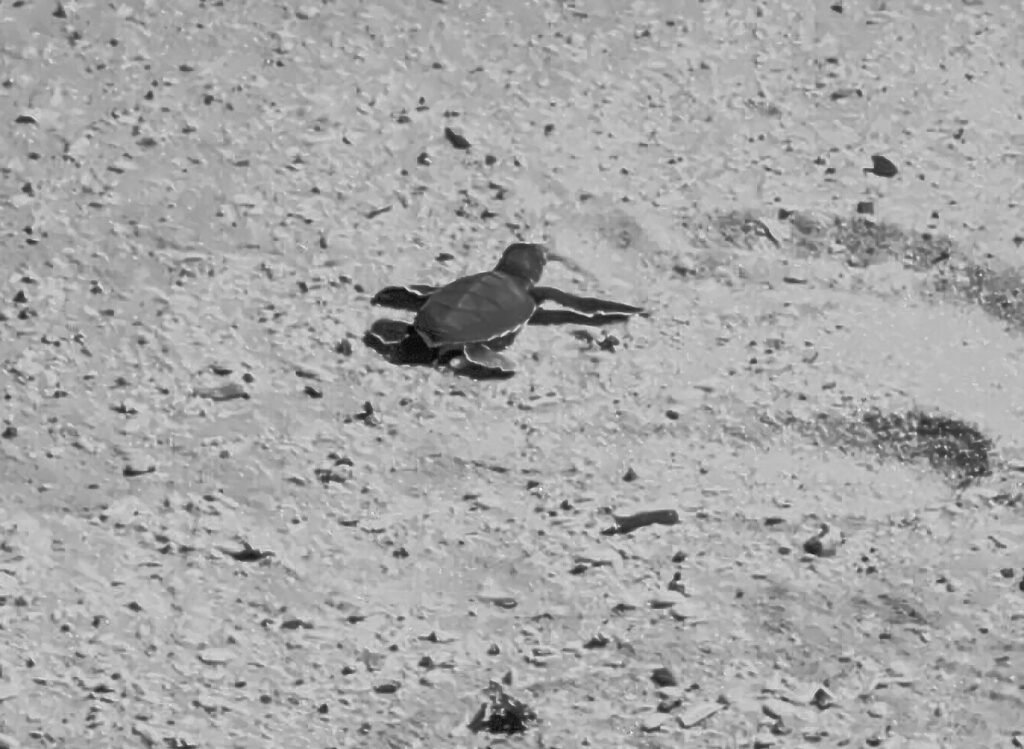
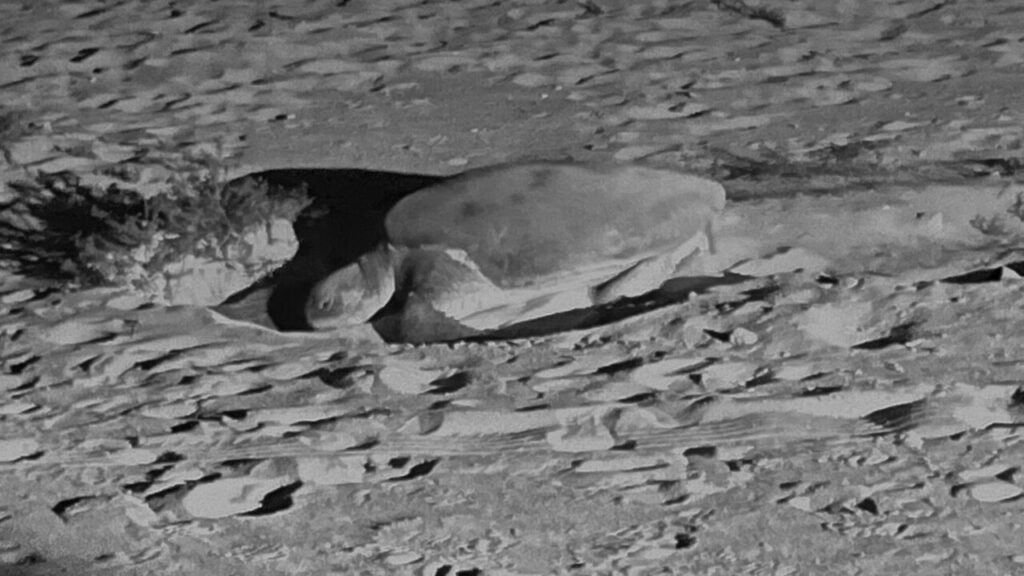
We silently left that drama to make our way in the moonlight further along the shore to where a guide had located an adult mother (no relation to the hatchling) attempting to find an appropriate spot to lay her eggs. She was digging. And digging. Front flippers flinging sand in great heaves that required her to rest occasionally before continuing. She started fresh at five different locations while we watched, struggling to find just the right sand – not too dry, not too wet, but damp enough to have some structure – where she could deposit her fertilized eggs in safety. No success. Later that night, she would return to the ocean and rest a bit before trying again the next night.
Oceans of Sand
Leaving the Ras Al Jinz, we headed to the desert – specifically, to the Wahiba (Sharqiya) Sands – an area of Oman renowned for spectacular sand dunes. We were immediately captivated by the stillness of this arid land. There’s a mystical charm in the pristine beauty of this landscape. While it seems barren at first glance, this desert is home to a surprising variety of flora and fauna, and we were treated to up close encounters with camels, goats and Arabian gazelles.
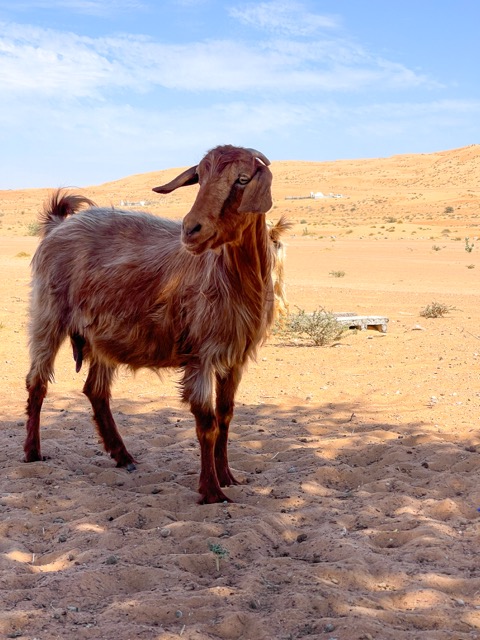
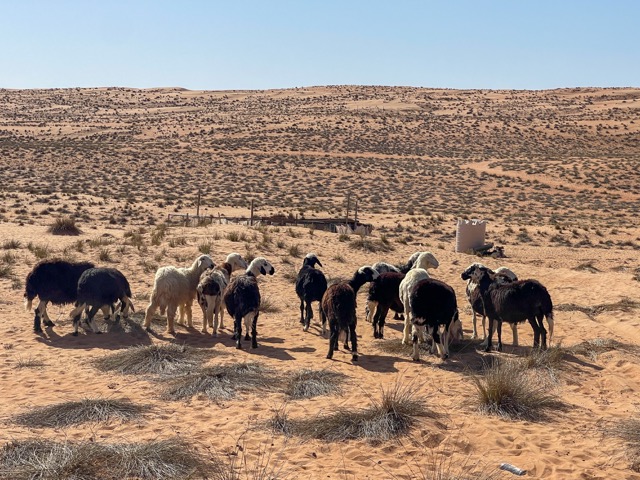
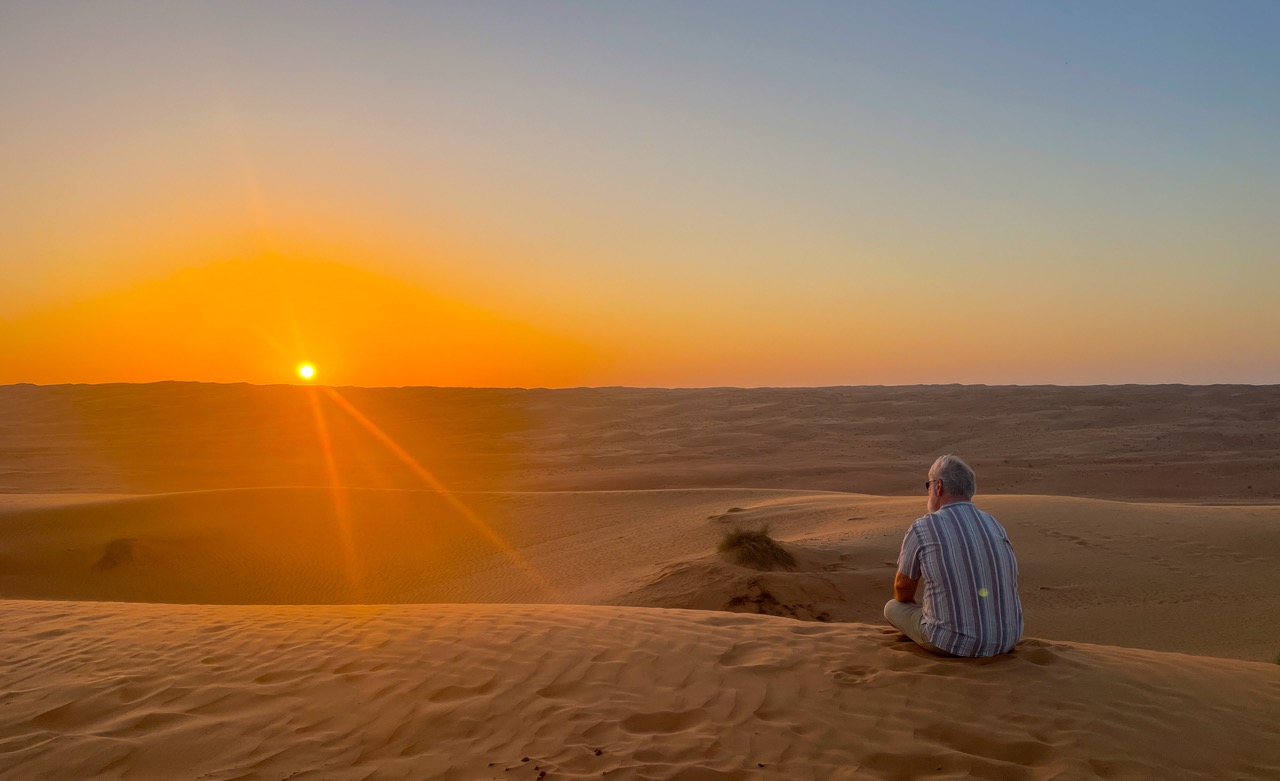
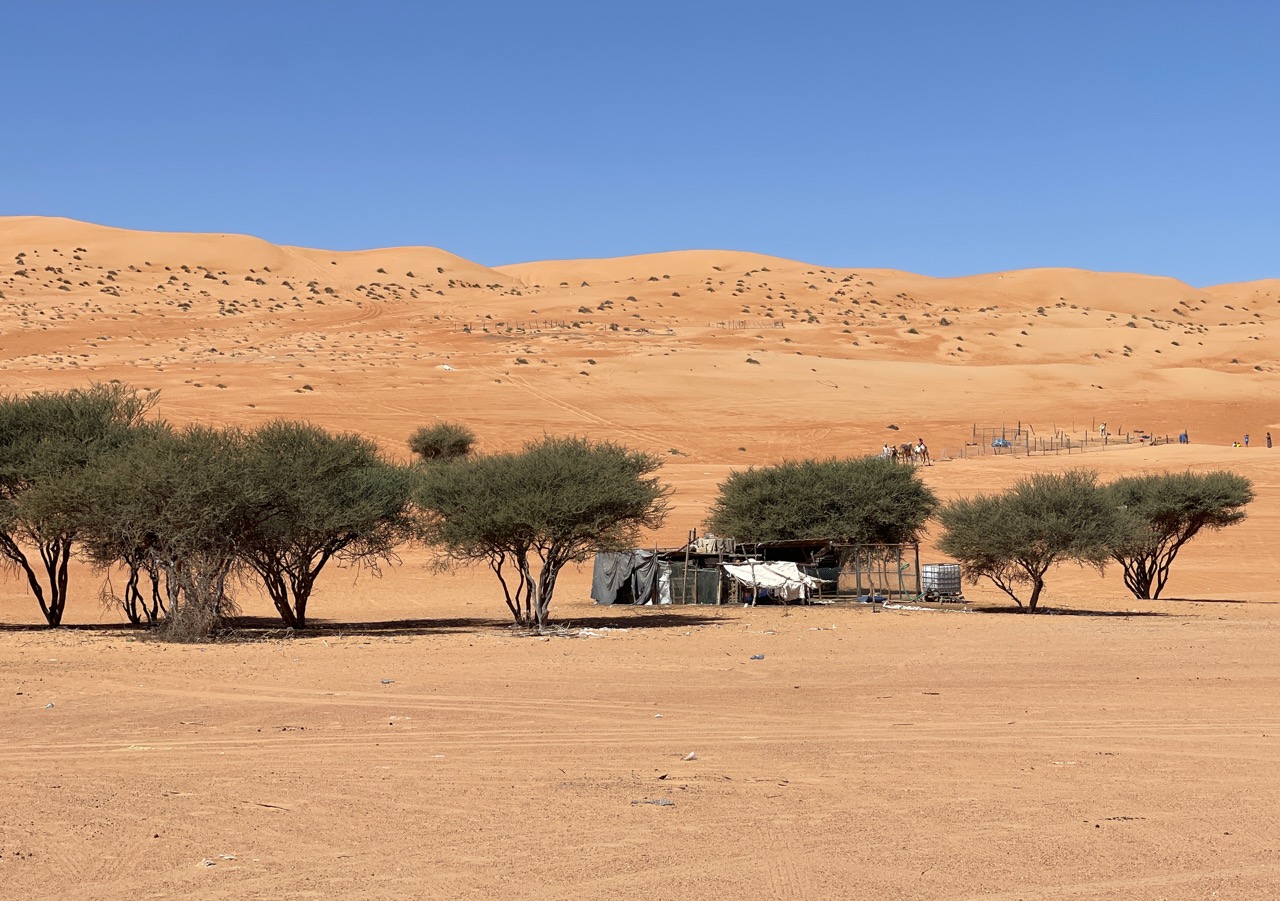
Pale gold at noon, the towering piles of sand shift between rich yellow and coppery orange when the sun is at lower angles. Experiencing the primal power of the desert from the comfort of a luxurious tent was surreal. After climbing to the top of a dune to watch the sun set, we sat by an open fire and then dined on local cuisine including the traditional Omani lamb shuwa and a delicious camel meat stew.
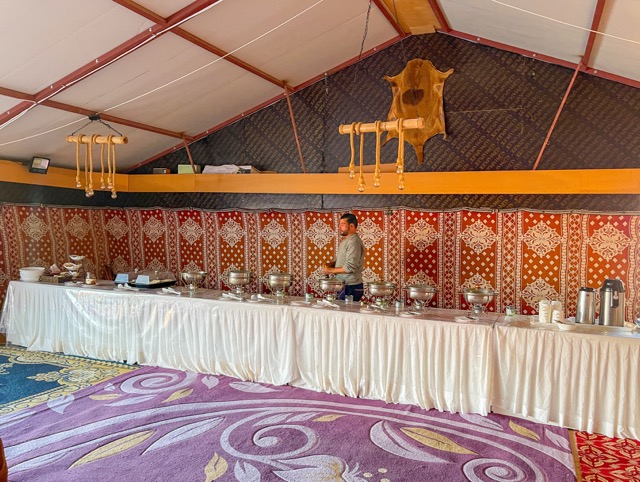
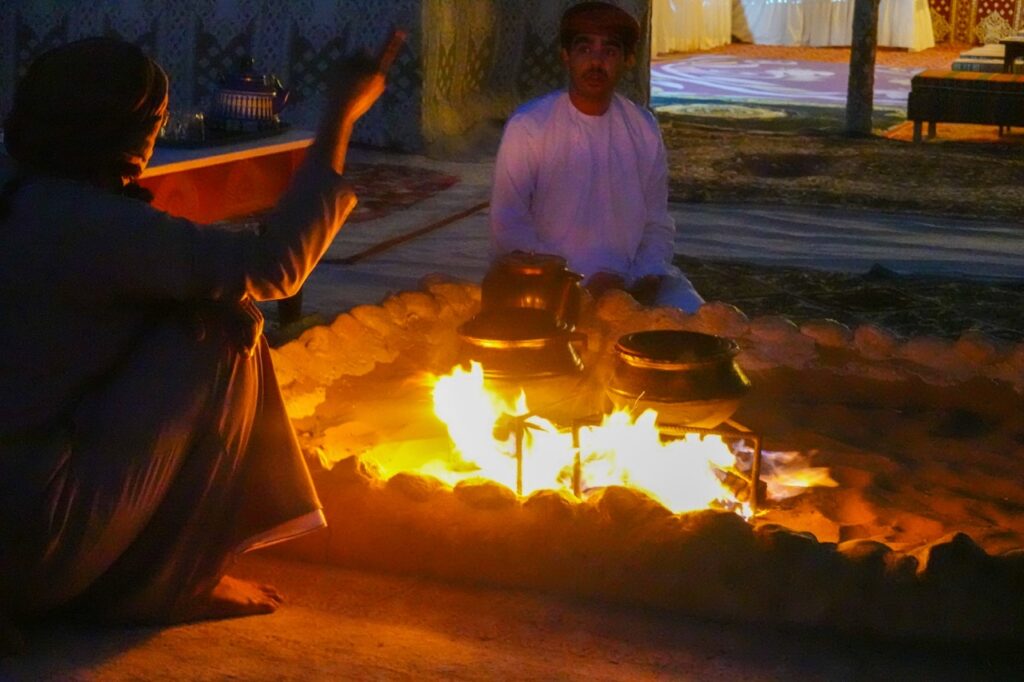
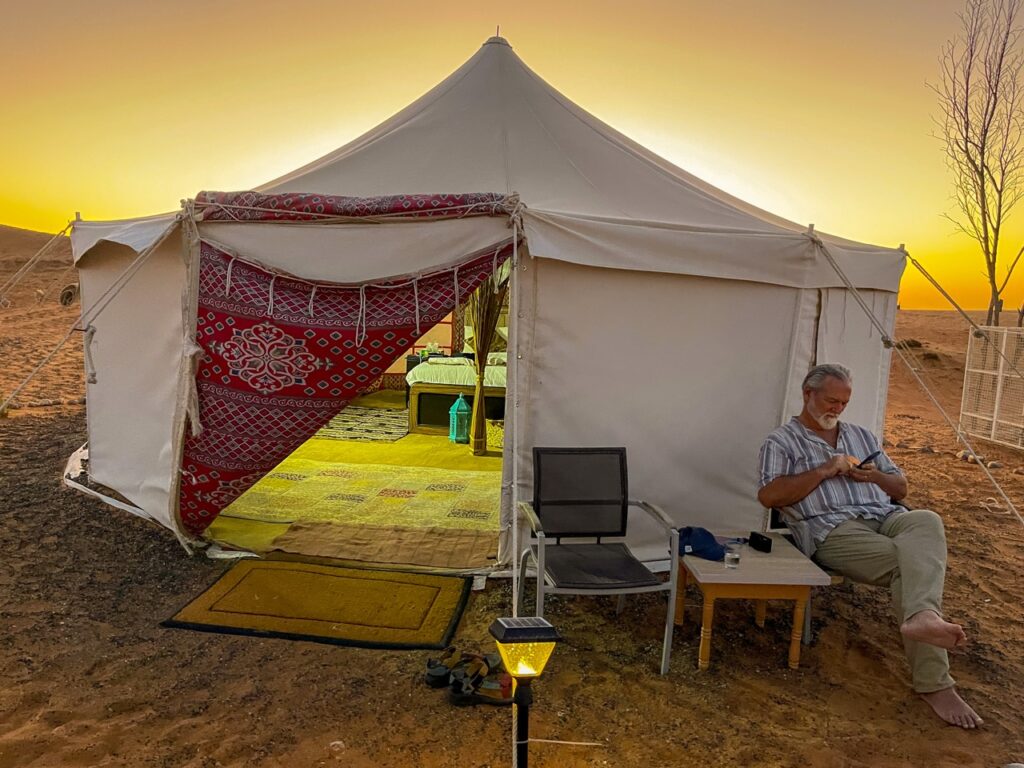
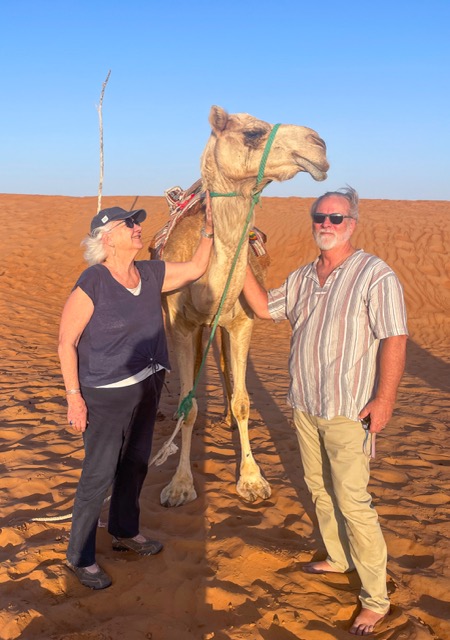

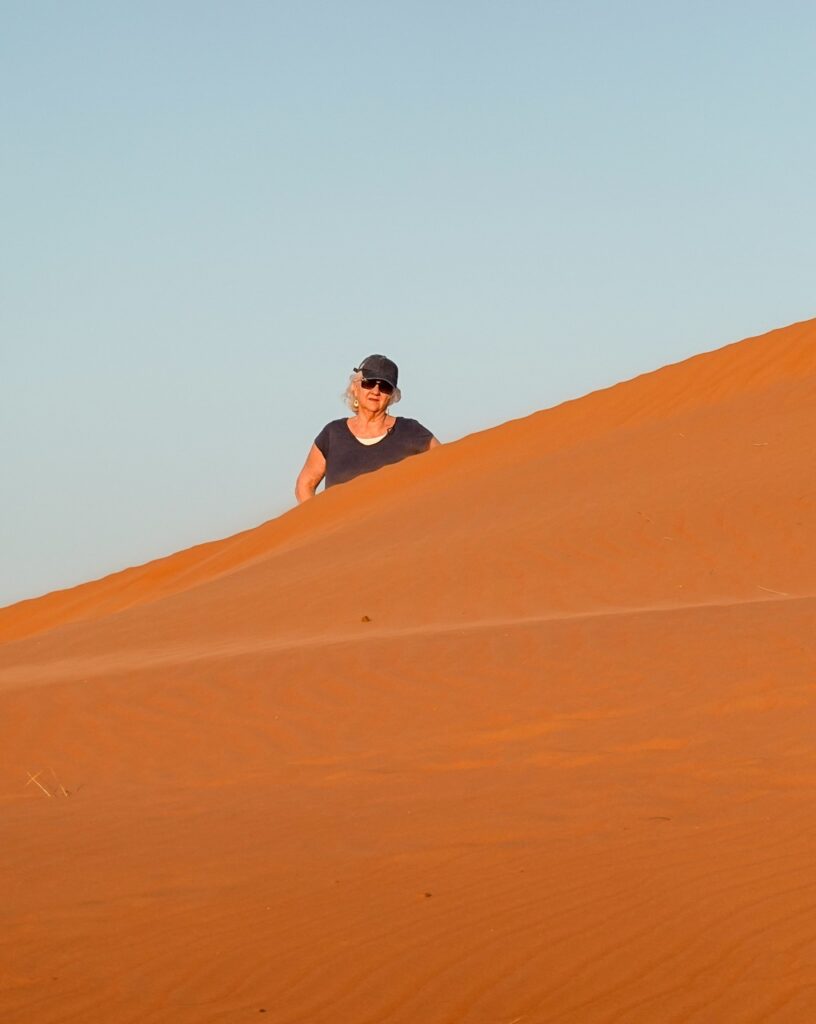
Oceans of Life
Reluctantly, we left the serenity of the desert and headed back to the hustle and bustle of Muscat where we had booked a dolphin tour from a local marina. As with turtles, there are no guarantees about dolphin sightings. While we were ferried to the marina to board a boat, we prepared ourselves to enjoy being on the water, but we boarded with expectations in check. Off we sped to a point perhaps a mile off the coast where we began to spot the Spinner and Bottlenose dolphins that are typical along the coast of Muscat. Delight, rather than disappointment, ensued as we enjoyed the dolphins feeding and cavorting in their natural habitat. Hundreds of dolphins jumped and frolicked around our boat for more than an hour. It was a wonderful and relaxing.
A little-known fact: Oman’s waters are home to about 25% of the world’s population of whales and dolphins. As we were cruising about watching dolphins, someone on the boat announced they had seen a whale. Then, as I was turned to my left to watch a pod of dolphins, I heard the unmistakable sound of a whale spout to my right. I turned quickly, and said, “Oh, Hello!” as the magnificent creature surfaced just a few yards from our boat.
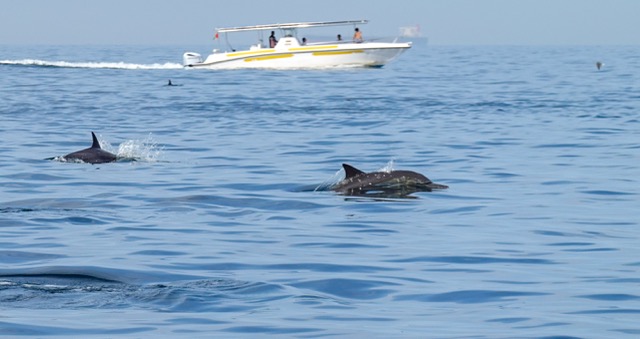
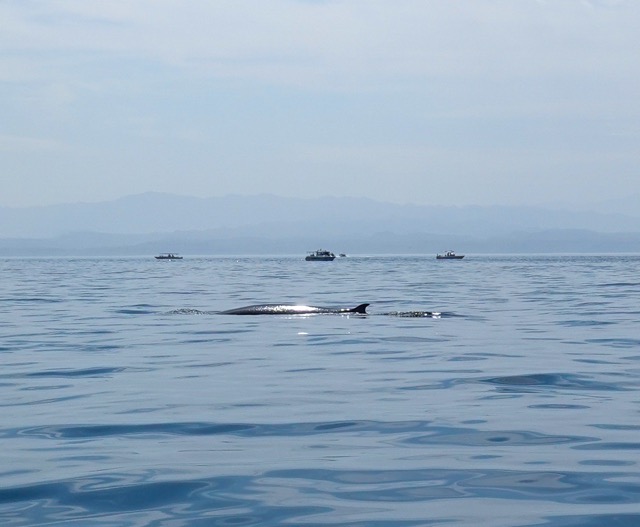
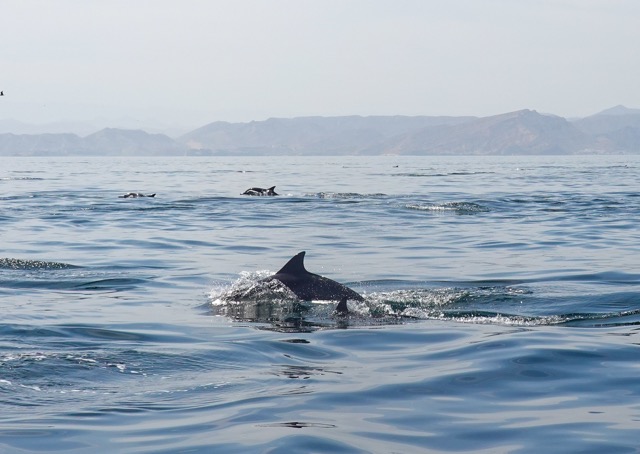
The Boundry
Our road trip from Muscat to the Ras al-Jinz Turtle Camp offered a spectacular view of Oman’s corniche – a road built along a coast along the face of a cliff (which we have some familiarity with having driven along the Mendocino Coast countless times). The trip back to the marina after dolphin and whale sightings provided another perspective of the amazing Omani coastline.

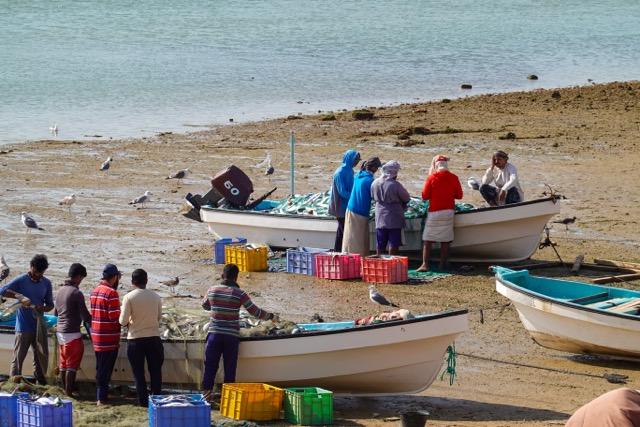

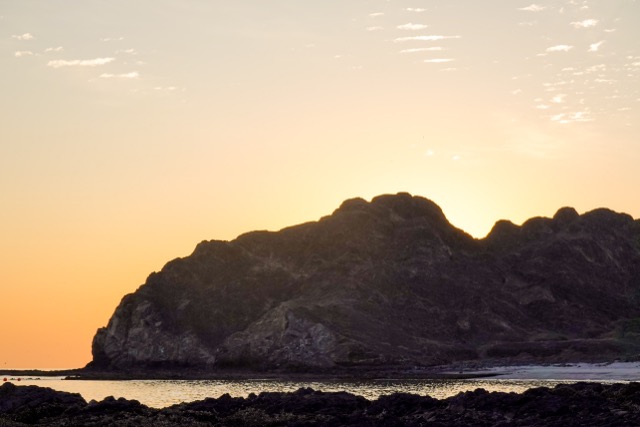
In our reading we’ve seen Oman referred to as a geologist’s paradise. Apparently, Oman is the only place in the world where we can see the “Moho” – the boundary between Earth’s crust and the mantle (an underlying layer of denser rocks in Earth’s interior). Okay, geology is not our strong suit, and this revelation left us feeling distressingly unprepared to appreciate the alien landscape we found ourselves traversing. We resolved to correct this deficiency before any new adventures, and immediately began a lecture series from the “Great Courses” on Geology 101 when we got home to Valencia. Look out. There are rocks in our future!
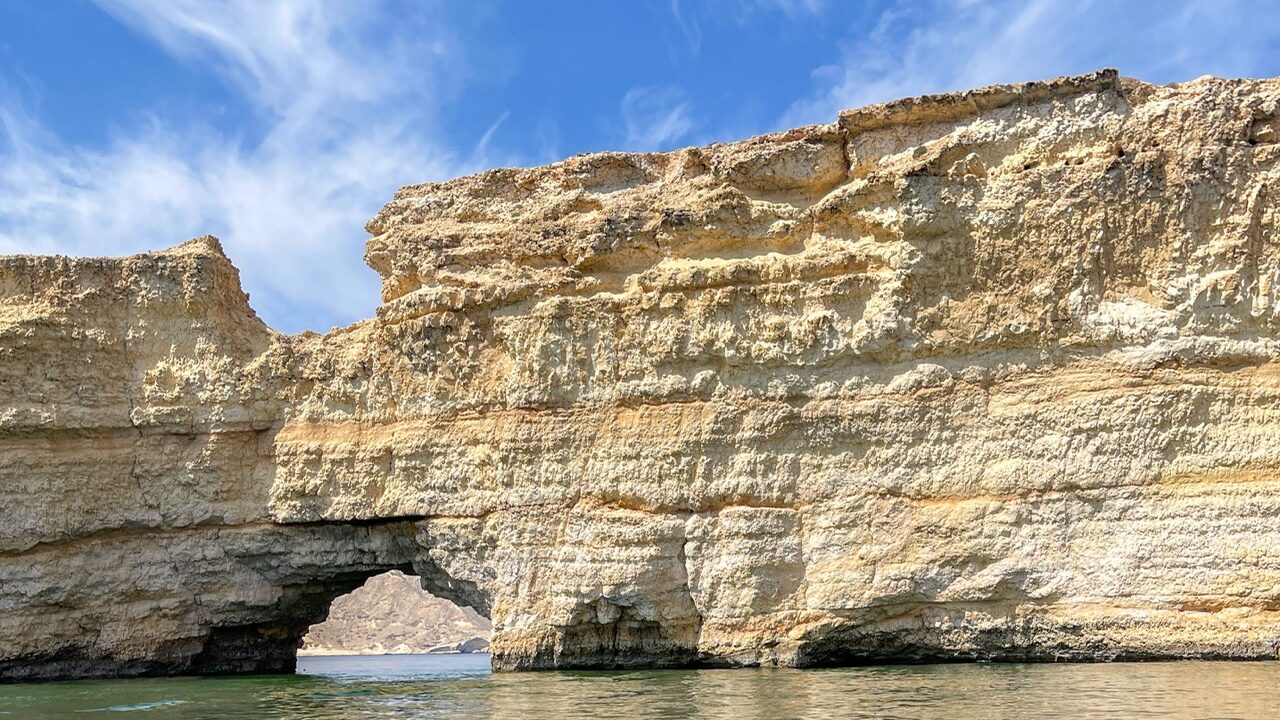
Awakening to Omani Culture
We began this trip with a number of well-worn preconceived notions about “the middle-east” – conservative, repressive, nouveau riche bling, etc. Forty years ago, I was involved in a major construction project in Riyadh, Saudi Arabia. It was, in fact, an extremely repressive, ultra-conservative culture just beginning to reach for the bling. Now, I will readily admit that one week in Oman as a tourist does not begin to qualify as cultural immersion. It was, however, enough exposure to recognize that it is well past time for a serious revision to our prejudices and judgements. Almost nothing we thought we knew is true.
I’m going to skip over any discussion of Doha from a cultural perspective because we were only there for two nights. And, because millions of words were written on the subject in the run-up to the 2022 World Cup by people with far more knowledge. I would caution, however, that we live in an age of “information” overload where it is very challenging to parse out the nefarious agendas and biases contained in almost every source to which we are exposed. It turns out, you just can’t believe most of what you read (or hear, or see, for that matter).
Diversity
Over the centuries, Oman’s capital, Muscat, has played a crucial role in a flourishing trade between Arabia, Africa, and Asia. Merchants from around the world passed through the city, exchanging a variety of goods, from spices and textiles to precious metals and gemstones. This rich trading history left an indelible mark on Muscat’s culture that must, in some respect, account for the enormous diversity in the country today. In just one week, we met and talked with people from Bangladesh, India, Zanzibar, Indonesia, Pakistan, the Philippines, Sri Lanka, Sudan, Switzerland, France, Denmark, Qatar, the UAE, Iran, and of course, many Omanis. Not once did we run into another American.
There are hundreds of thousands of Indians who have been living in Oman for centuries due, primarily, to their trading relationship throughout history. The main observable difference is that the Indian kids play cricket, while Omani kids play football – usually wearing Barcelona shirts. Many Omanis have East African ancestry: they colonized places like Zanzibar hundreds of years ago. As we traveled and interacted with this amazing array of people from various cultures, we slowly came to the realization that all of them, without exception, were happy and loved living in Oman. And friendly. Of all the places we have traveled (a list far short of our aspirations) the people of Oman are the most welcoming and friendly we have experienced, and it’s not close. They are quick to laugh or make a joke, go out of their way to assist total strangers, and overwhelm you with their hospitality. Of course, with all these diverse cultures and traditions coming together in one place there must be a lot of conflict and tension along religious and ethnic lines, right? Nope. None. This is a peace-loving culture which just might be the closest to the proverbial melting pot that we have experienced.
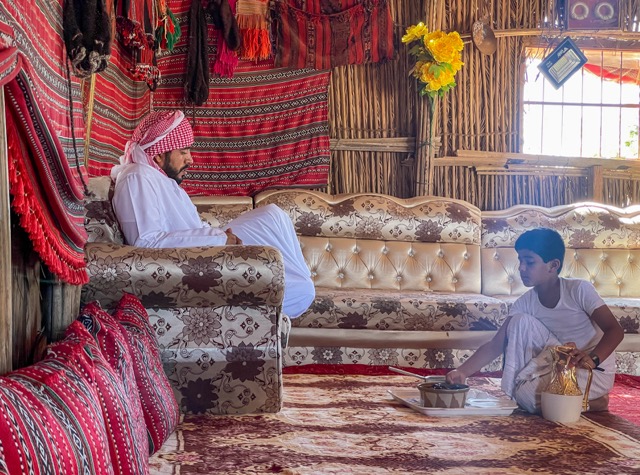
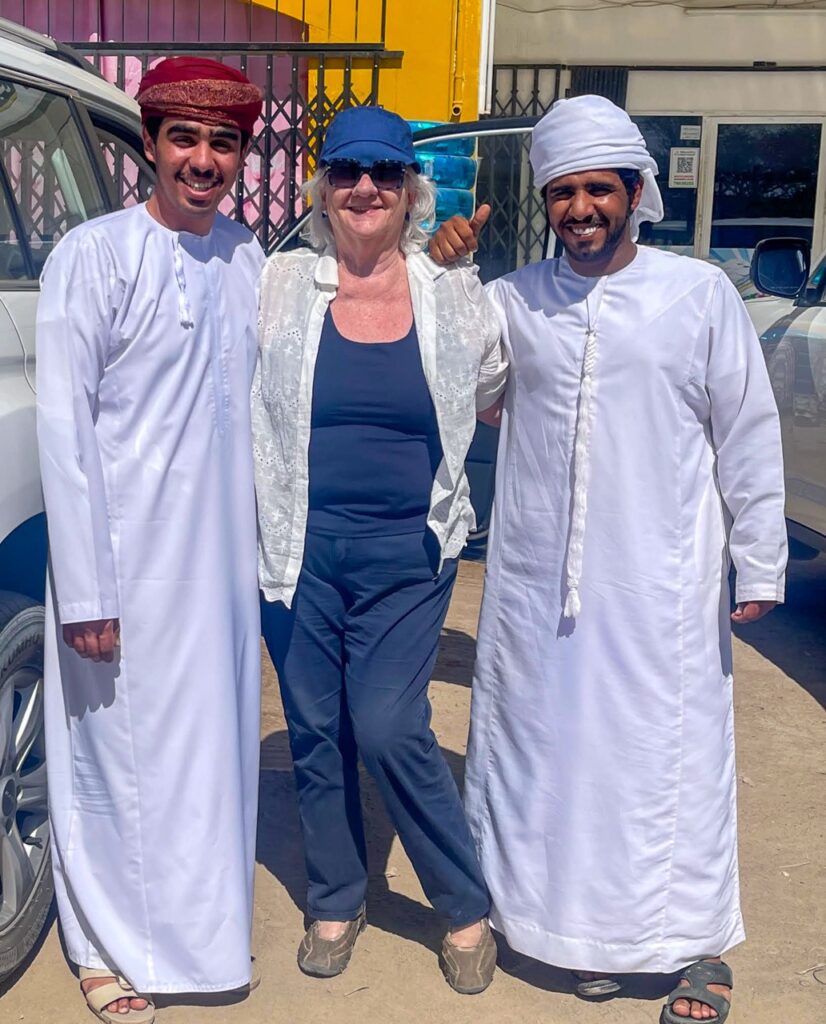
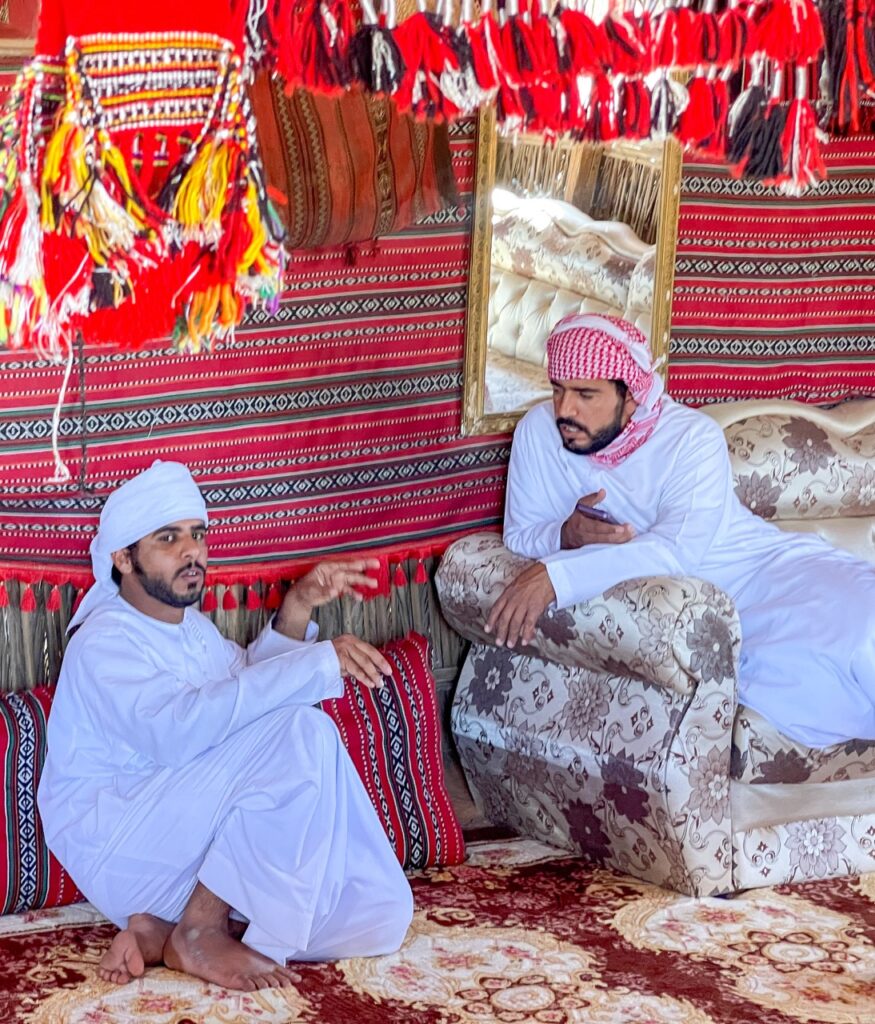
Unlike just about everyone else, Oman has stayed out of the geopolitical conflicts in the region. Although a member of the Gulf Cooperation Council (GCC), Oman is a neutral and non-interventionist State with regard to the war in Yemen, keeping communication channels open for different actors in the wider Middle East. Home to hundreds of refugees from Iraq, Syria and Pakistan, they have adopted a humanitarian stance, sending cash and aid to Yemen, and allowing Yemeni citizens to cross the border for care in Omani hospitals. No wonder we, like most U.S. citizens, know so little of this peaceful little nation: good news rarely makes into our data streams.
An Example of Leadership
A significant amount of credit for the remarkably peaceful, safe, and joyful state-of-affairs in Oman must go to the work of His Majesty, the late Sultan Qaboos, who overthrew his father in a peaceful coup around 1970. (Daddy was sent into exile at the Ritz Hotel in London!) Until then, Oman had been impoverished and riven by tribal conflicts with only a couple of hospitals and schools in the whole country. Sultan Qaboos set about methodically improving his country, concentrating on education, health, gender equality, and the construction of civil infrastructure. He didn’t squander the wealth that came from his country’s natural resources (mainly natural gas) on grandiose schemes, nor was he a kleptocrat who looted the country’s wealth for himself, in contrast to rulers of other gulf states. Modern Oman’s society and economy resembles Denmark more than Dubai.
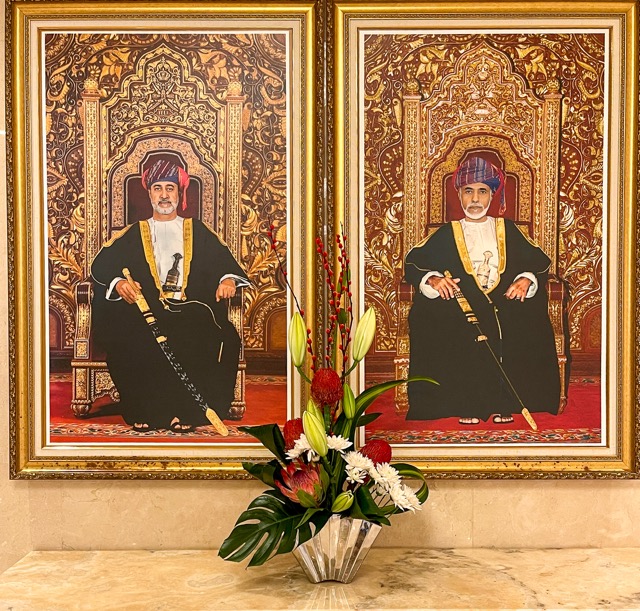
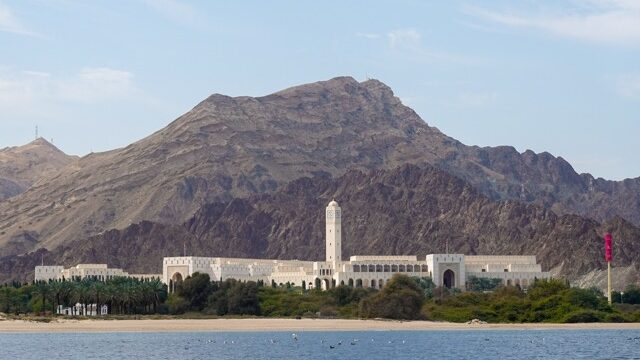
The Clothes We Wear
Yes, but what about the oppression of women? What about the burqa? These questions are a big issue for Bonnie and I. And, like many in the west, we see these black, head to toe garments as symbols of oppression and worse. They represent something vaguely frightening and sinister. Once again, however, maybe we need to check what we think we know.
First, let’s deal with the religious elements of this tradition. No where does the Qur’an require that women cover themselves from head to toe. In fact, this style of dress was in place long before Muhammad’s visions in the desert. Protection from the desert environment and protection from tribal raiding parties was the primary motive for this mode of dress. For the Bedouins who originated it, in other words, it was cultural. And, like many cultural artifacts and practices, it was appropriated by religion once Islam was up and running as a political power. And, as religions are run almost entirely by men, for their own benefit, they found that the imposition of requirements such as the burqa served their interest. (If you want to see Bonnie get really wound up, ask her sometime about the restrictions men impose on the Amish women in our area of Pennsylvania.) So, our initial revulsion is not without some grounding. Except, once again, its cultural, and maybe more complicated than we would like to admit.
Oman is a predominantly Ibadi Muslim culture (as opposed to Shiite or Sunni) where local women wear a full-length abaya and a hijab covering their heads. It is uncommon to see women in Oman in a niqab (full face and body coverings). Afghanistan is currently the only country where the full burqa is legally required. Whenever we had the opportunity to have an extended conversation with an Omani, we brought up the subject as respectfully as possible. They challenged our assumptions. Without exception, everyone stated that their style of dress is a choice. This seemed to be especially true for the newest generation. Grandmothers almost universally wear the traditional abaya and hijab. Mothers and their daughters, however, are increasingly choosing a more European style. One thing that is almost universal in Oman is a head covering for both men and women. Men all wear a muzzar (a round, fabric cap), with or without an additional square scarf known as a keffiyeh, worn either Bedouin style, or as a turban wrap. Women wear a variety of shawls and scarves, folded and tied in creative forms, but all serving the same purpose – to cover the head – and make a fashion statement. These are the trappings of culture: dressing to fit in.
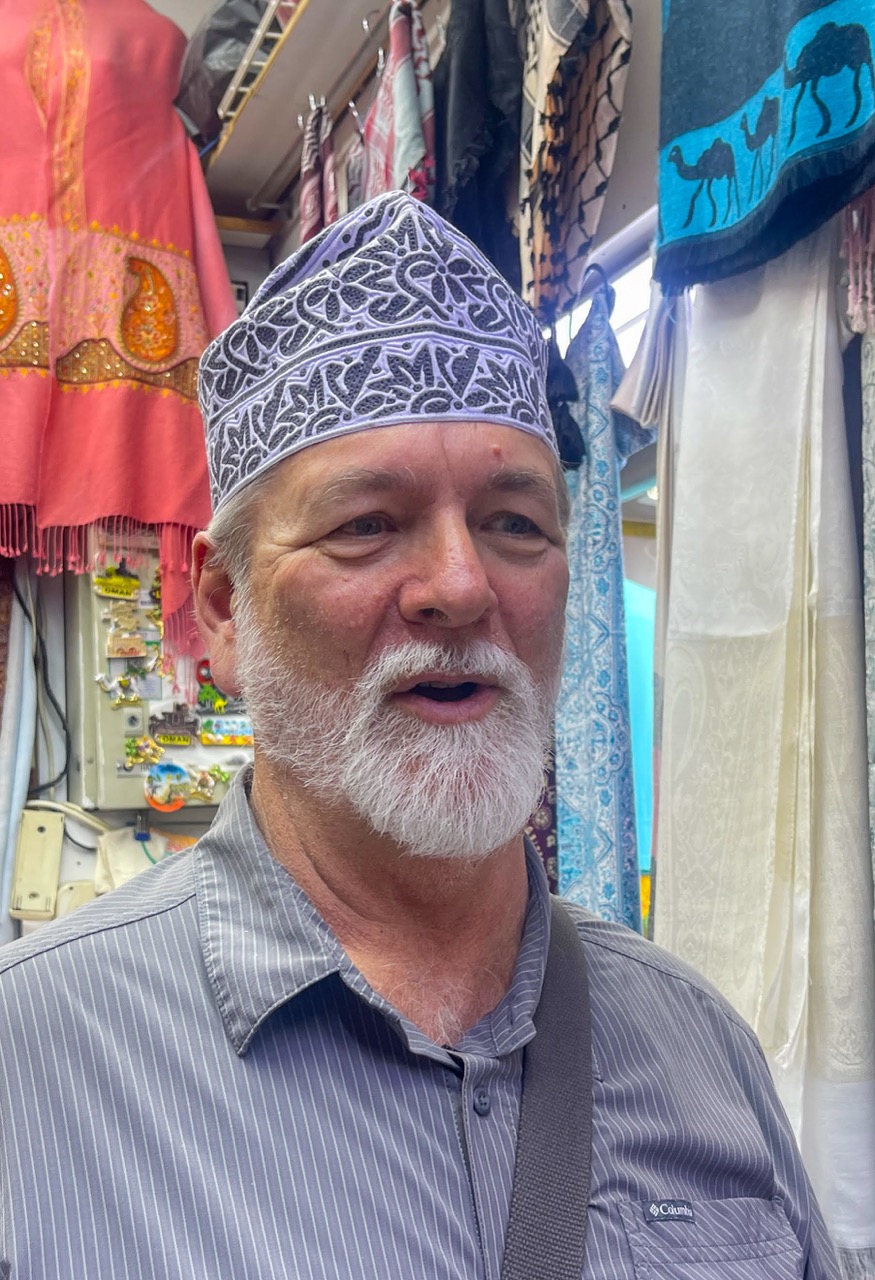
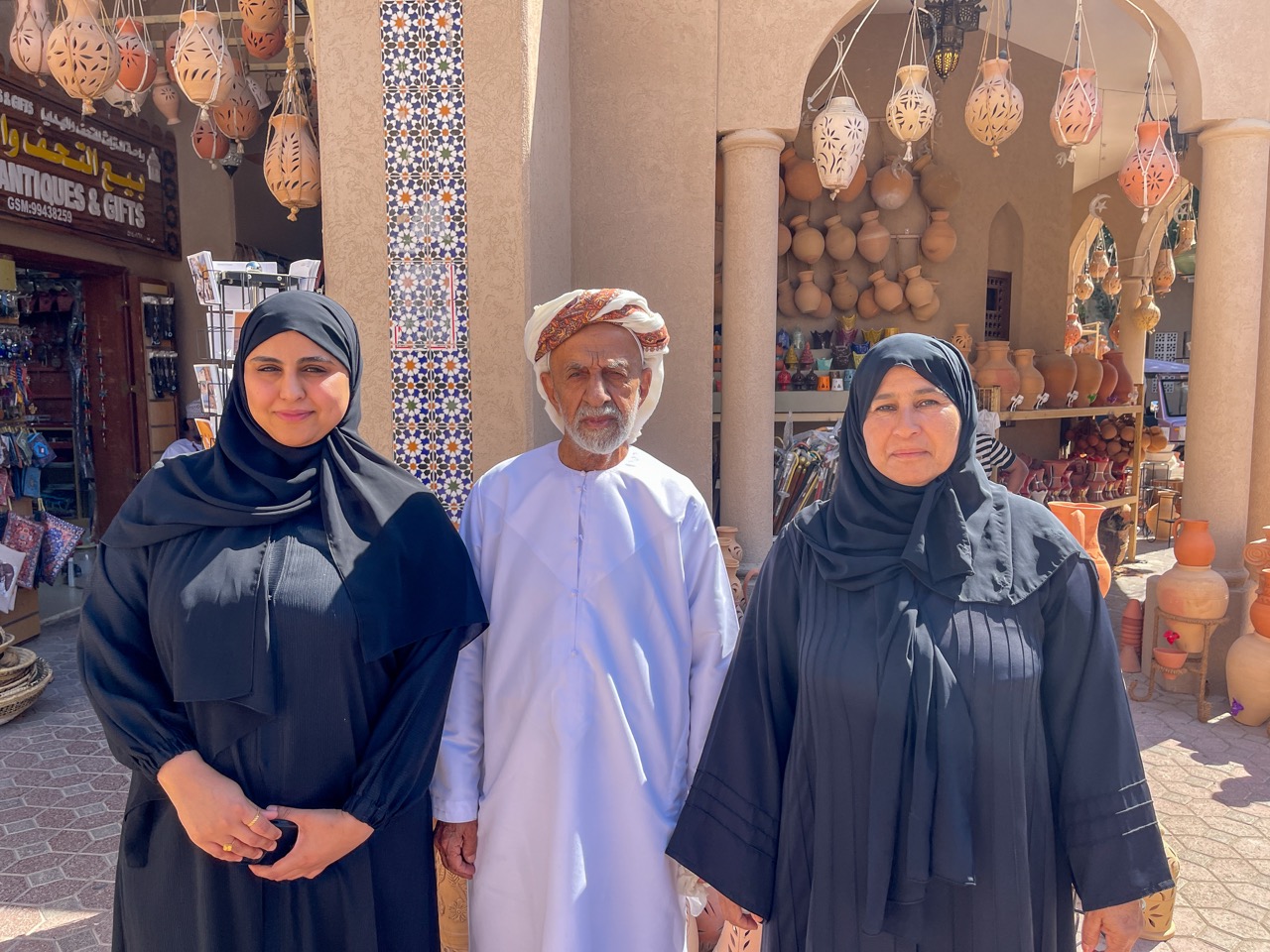
Trying to put all of this into context, I began to think about the oddities and silliness of cultural imperatives in the U.S. just in my own lifetime. There was a time when men were considered undressed without a hat. There was a time when it was scandalous for a woman to wear pants in public (something to ponder in the age of the ubiquitous yoga pant). It’s still considered a bit risqué in the U.S. for women to go braless in public (not so much in Europe). And, like the desert inspired hajib and keffiyeh, there are many examples of fashions born of practical solutions to environmental circumstances. Blue jeans, for example, which have become the universal symbol of western dress, were created as a rugged, inexpensive garment capable of holding up to the rigor of the California gold fields in the mid 19th century.
Open Minds and Hearts
To summarize: once again, travel has challenged us to open our minds and make room for the vast variety of cultures and practices that are often simple, beautiful expressions of our humanity. It is a conundrum of profound significance that in this era of instant global communication, where the opportunity for cross-cultural sharing and understanding has never been greater, we are becoming more intolerant and polarized. I think I need another evening on my sand dune.
I must share one more anecdote. Our first evening in Muscat, we were eager to see a bit of the traditional shops in the Muttrah Souqs and find a bite to eat, so we hired a taxi for the evening. Jamal proved to be gregarious, talkative, and eager to share his homeland with us. He offered a non-stop stream of opinions, suggestions, and pointers while we drove around seeing the sights. We were particularly grateful to him for guiding us to a traditional Omani restaurant, which he proclaimed made the best Shuwa (spiced lamb buried with hot coals to braise overnight). This was so good we began looking for it on every menu.
On the way back to the hotel, with our energy and the conversation waning, Jamal wanted to play us some music. We asked for something traditional from Oman. “No, no,” he said. “What is your favorite classic?” Classic? What is he talking about? After some back and forth, he became impatient with us and said, “Ok, I’ll play my favorite.” After a moment the first bars of an instantly recognizable Eagles tune began to fill the car: welcome to the Hotel California. Jamal sang along as though greeting an intimate friend and near the end turned to declare, “this is my favorite line!” Mirrors on the ceiling, the pink champagne on ice. And she said, “We are all just prisoners here.”
Art & Architecture
Our adventures in Oman began with a stopover in the capitol of Qatar. The descent into the Doha airport produced a bit of apprehension. One feature of the Arabian Peninsula that has not changed from my first exposure 40 years ago is the dust. As we descend, the air thickens with the stuff, dimming visibility and reminding me the of my lurking vulnerability to asthmatic symptoms in such environments. These concerns started to fall away, however, as we began to glimpse the jaw-dropping architectural creations that have bloomed in this port city. Since our time here was brief, we focused our attention on two major museums – The Museum of Islamic Art, and the Qatar National Museum. Both proved to be extraordinary and well worth prioritizing.
The Building Itself is Art
The Islamic Art Museum sits on its own little peninsula adjacent to a waterfront promenade with the bay and downtown skyline serving as a stunning backdrop. It is an I.M. Pei design, with an understated grandeur that projects a subtle, modern interpretation of traditional Arabic motifs. Pei was actually retired when the commission came up and he had to be talked into becoming involved. Once on board, however, he demanded full control and insisted on the creation of the little peninsula for the site to ensure that no future development could encroach on the building in the future.
I’m pretty familiar with Pei’s design approach (he was the design architect for the UCLA Medical Center that consumed a chunk of my career). So, it was particularly interesting to see a building where every detail was scrupulously executed to his standard without concern for cost. This, in fact, is a feature throughout Arabia where, over the past 50 years, the world’s greatest architects have been given carte blanche to produce whatever their imaginations might conjure without budget limitations. It is a unique moment in the history of design.
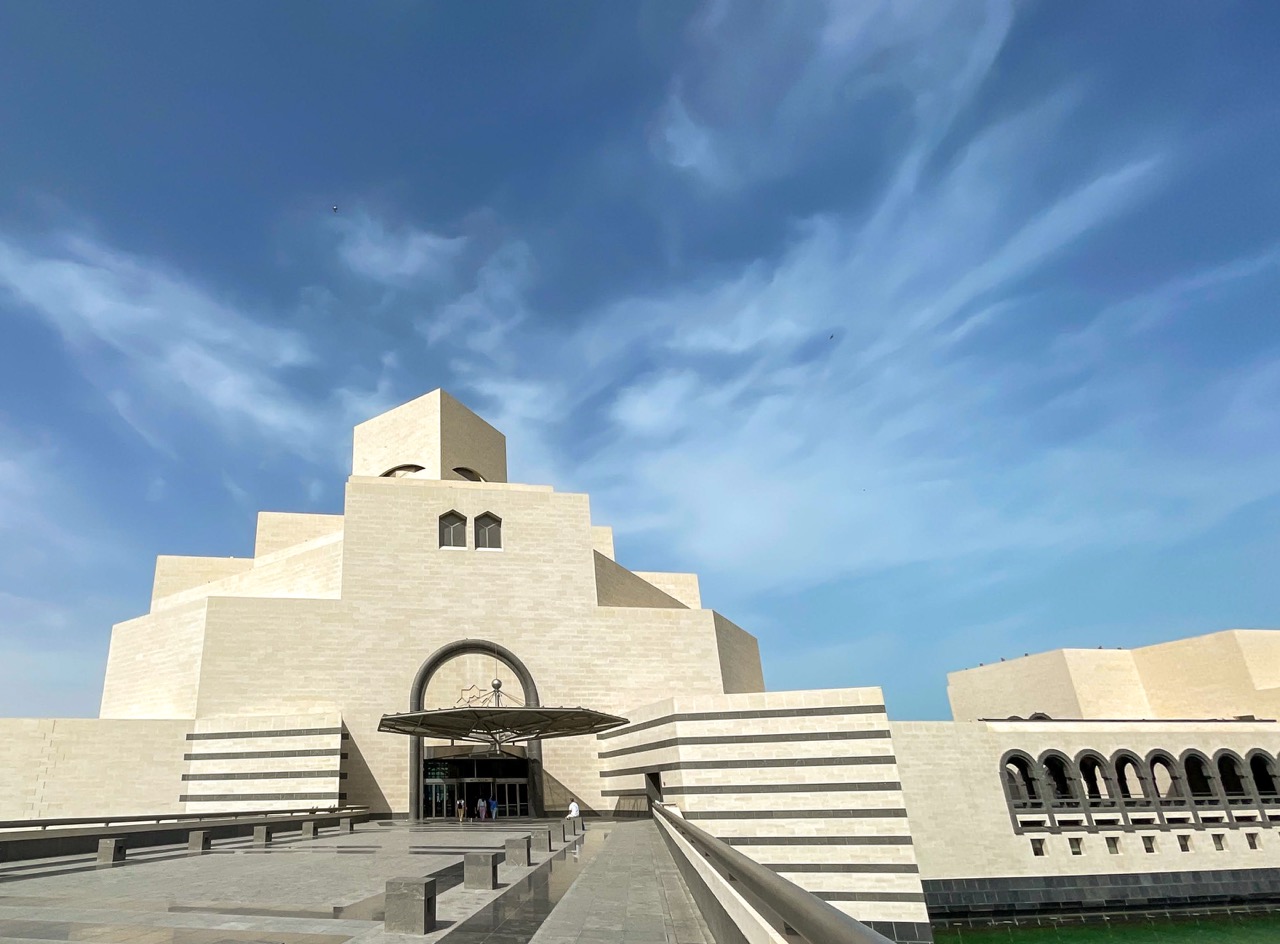
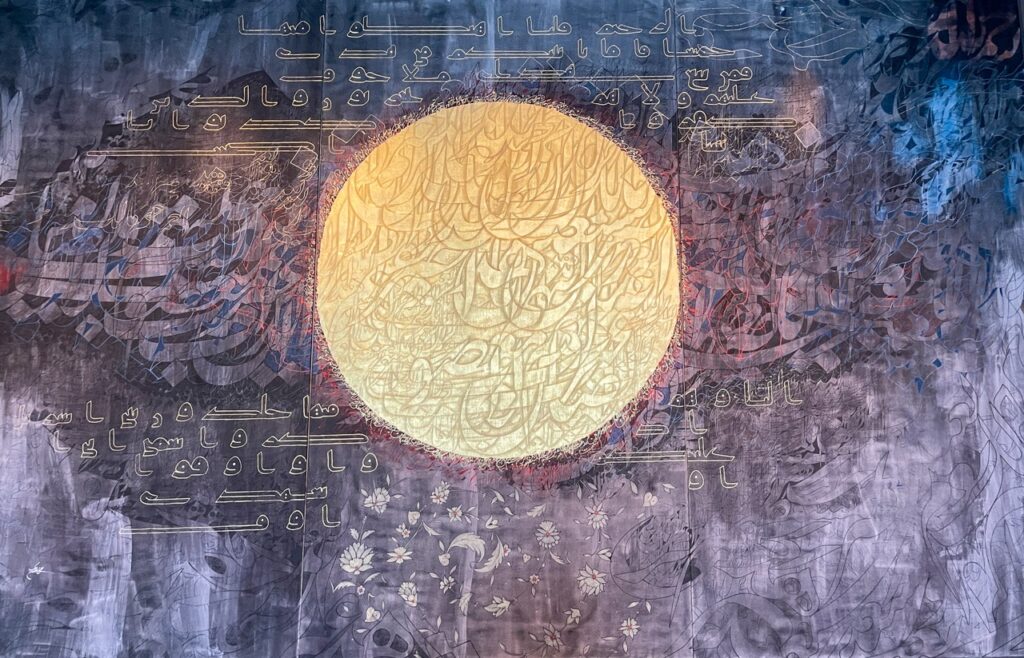
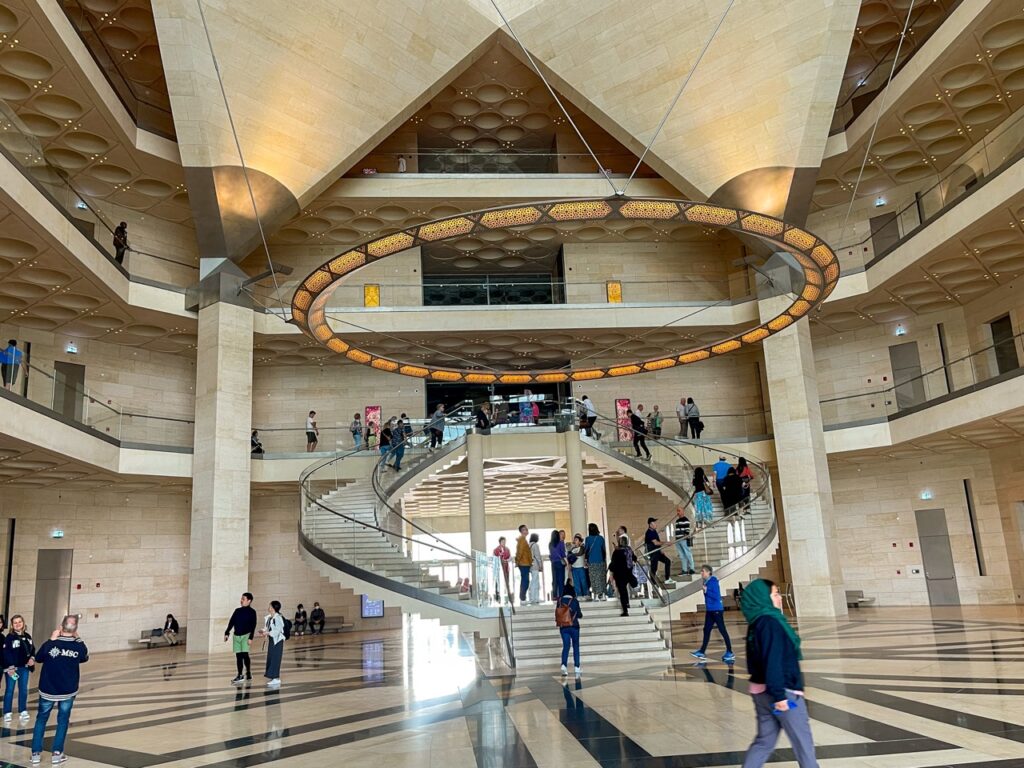
Intricate and Beautiful Designs
The collection held and displayed here more than lives up to the pedigree of the architecture. It is a magnificent survey of Islamic art across fourteen centuries, since the religion’s founding, from all corners of the Muslim world. There’s no filler here. Every item in the collection, exquisitely displayed with subtle lighting, represents a masterpiece of its genre.
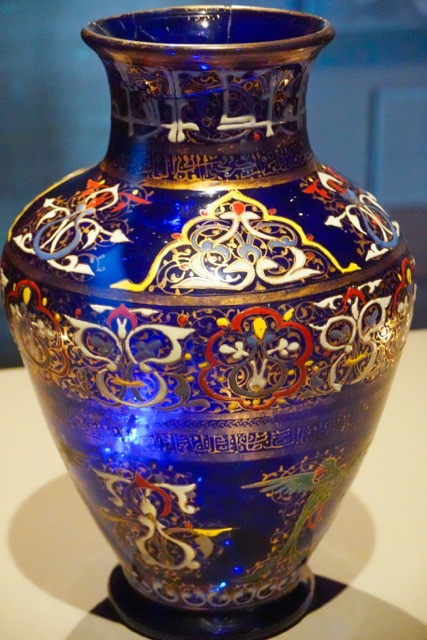
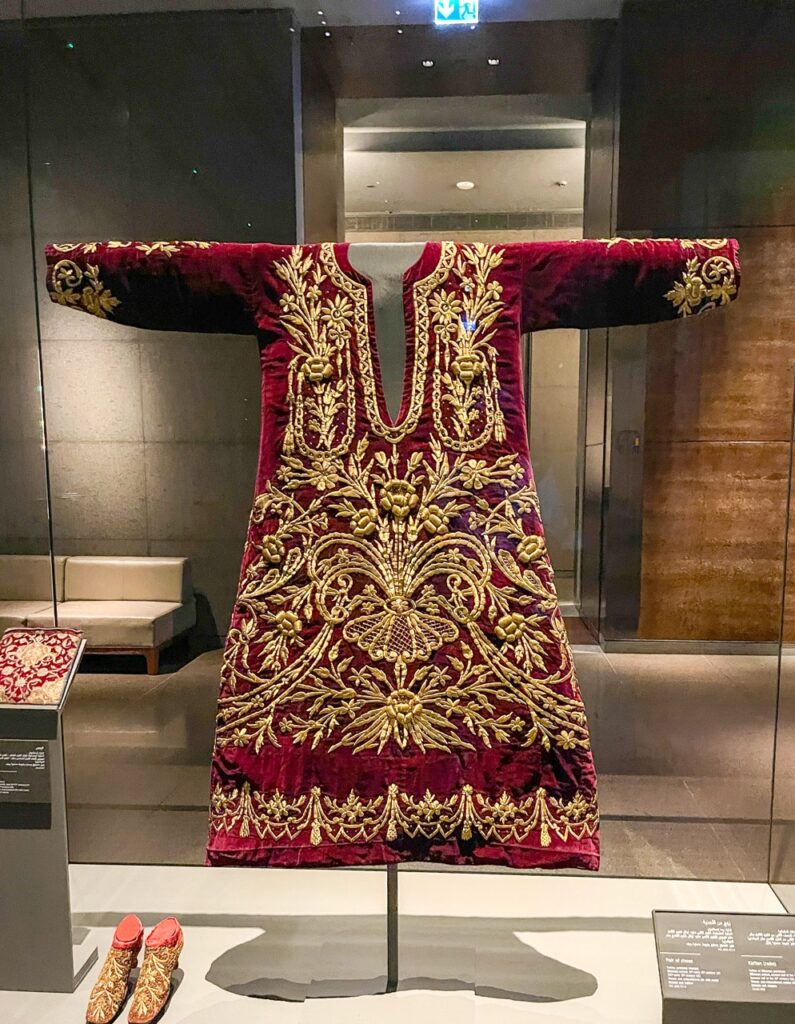
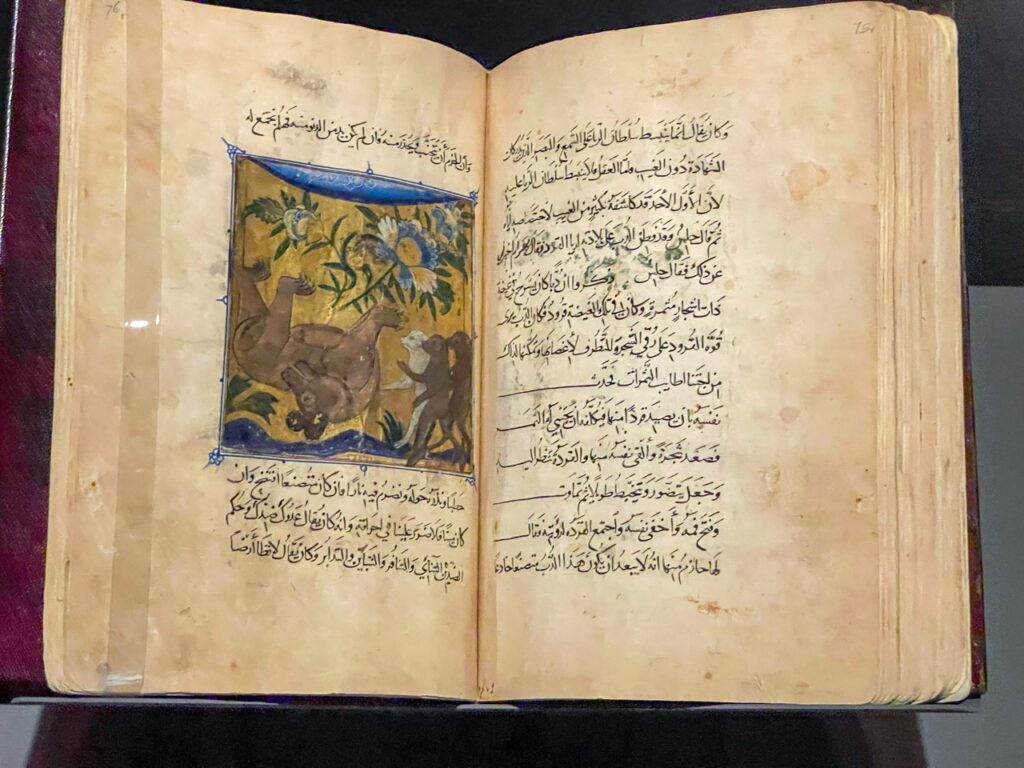
A Building in Harmony with it’s Location
Having failed to score a reservation at the museum’s Alain Ducassse restaurant, IDMA, we made our way to the Qatar National Museum a few minutes away to dine at their Michelin recommendation, Jiwan. Another world class architect, Jean Nouvel, has produced a creation uniquely suited to its location. Unlike Pei, whose work features a consistent palette of carefully worked elements that mark his designs like a signature, Nouvel is intent on something entirely new for each project. His focus is not on any particular style. Rather, he is intent on the harmony of the building with its location. To produce that harmony in Doha, Nouvel created a building that imitates the desert rose, a unique crystalline rock formation found in the desert sands of Qatar, and other similar landscapes. To be honest, we found this building nearly impossible to photograph, so I’m going to encourage you to visit this link: https://archello.com/project/qatar-national-museum if you want to see one of the most unique buildings ever constructed. So challenging was the execution of this design that the team responsible for the 3D modeling won awards for their work.
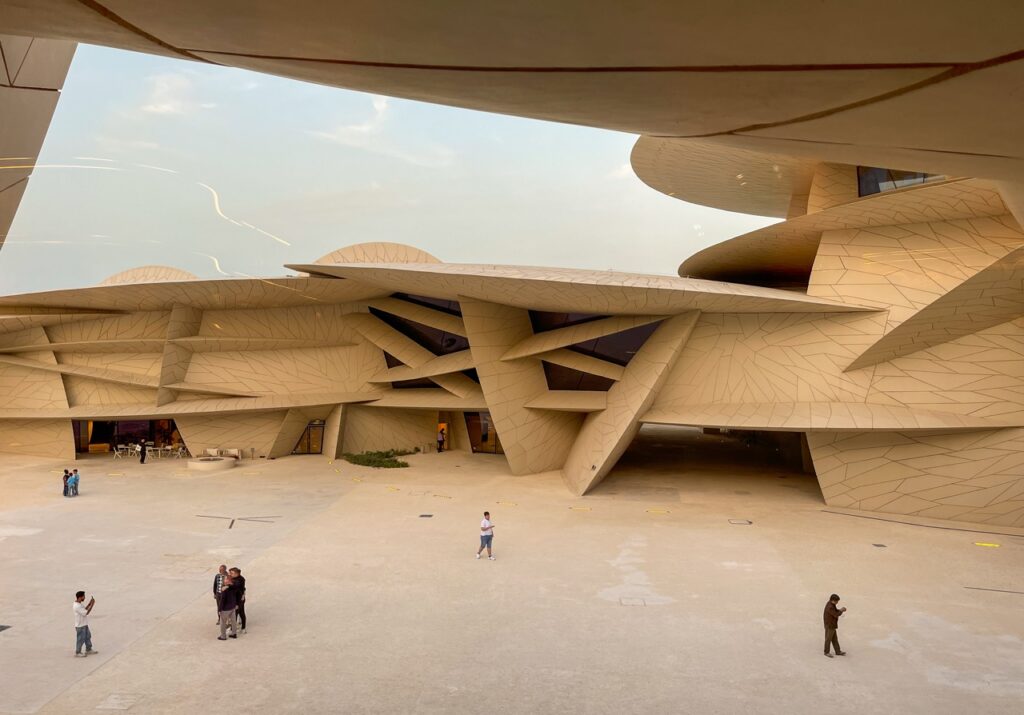
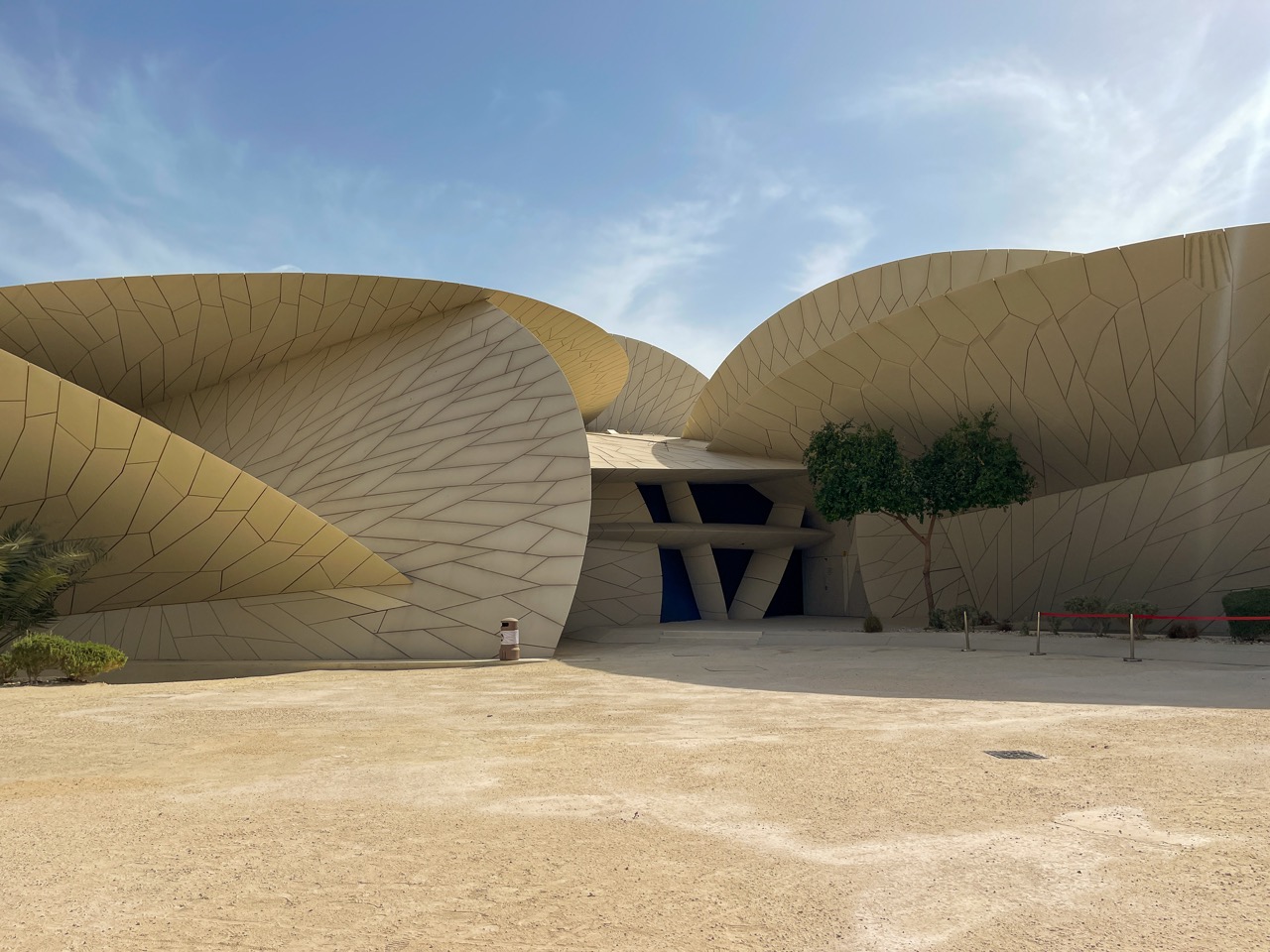
Inside, the exhibits trace the geology, history, and ethnography of Qatar from the beginning of time to the present day utilizing a dazzling array of artifacts combined with state-of-the-art technology. But what I was most striking for me was the relegation of the desert Bedouin lifestyle, which was prevalent just a generation or two ago, to an artifact of history. It is one more example of the speed at which our world is evolving and changing.
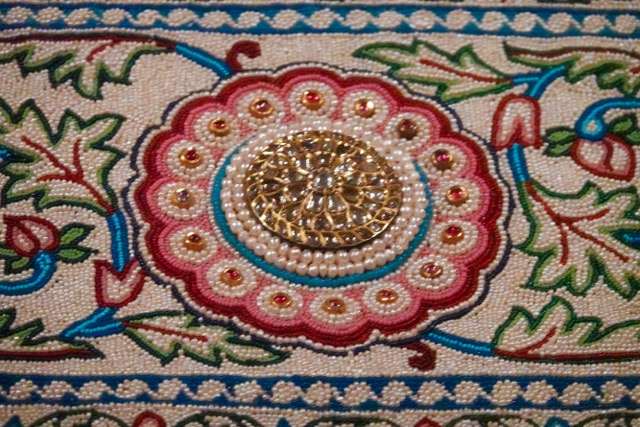
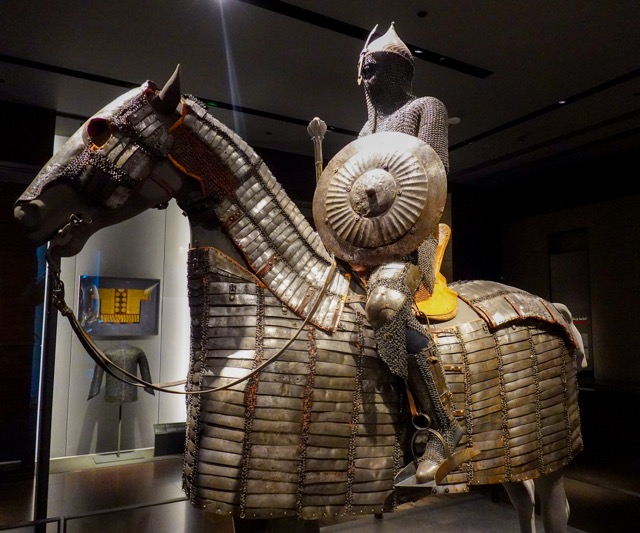
Having had our museum appetite well and truly satiated, we grabbed a taxi and headed to what remains of Doha’s old city to wander the souks. Our driver was not a fan of the old city. Why would you visit there with all the gleaming new city to explore? He did grudgingly recommend a traditional fish restaurant, however, where I picked a 2-kilo red snapper out of the ice to be grilled over an open fire. It was fantastic! Although, I must confess, I longed for a glass of crisp Alberiño to go with it.
Oman & Qatar – Technology Saturation
Traveling around the Arabian Peninsula can be a very disorienting experience for an American. Afterall, we’re the greatest nation on earth, leading the world in technology and innovation, right? I’m afraid once again, we’re going to need an update on our viewpoint.
Consider for a moment the pace of change that has been transforming Arabia. The massive energy industry that has funded the transformation began producing cash in earnest around 50 years ago. In my lifetime, Doha, Dubai, Bahrain and others have gone from small port towns on the Persian Gulf to world class cities of gleaming skyscrapers and sparkling luxury. Across the region, this scenario has played out over and over. The Arabia of 50 years ago has been relegated to museums, literally. And what to do you get when you build a new society with an unlimited budget? The best of everything, including the latest and greatest technology money can buy.
A Picnic with Muhammed
It was a small moment, but it beautifully illustrated the paradigm shift we were challenged to make. We’d just finished two hours of a riotous little adventure with a young Omani named Muhammad in the great desert known as the Sharqiya Sands. Muhammad introduced us to the apparently common practice of “dune bashing.” This is an excursion that involves pushing the capacity of a four-wheel drive SUV to the limits of the vehicle’s capacity to climb, slide, slip and dip over mountainous sand dunes for the purpose of terrifying foreign tourists. It is effective. Having satisfactorily elicited cries, whimpers, and the occasional hushed prayer from his passengers, Muhammad guided his modern beast to a stop under one of the few trees within sight and unpacked a beautiful carpet on which to spread a small feast.
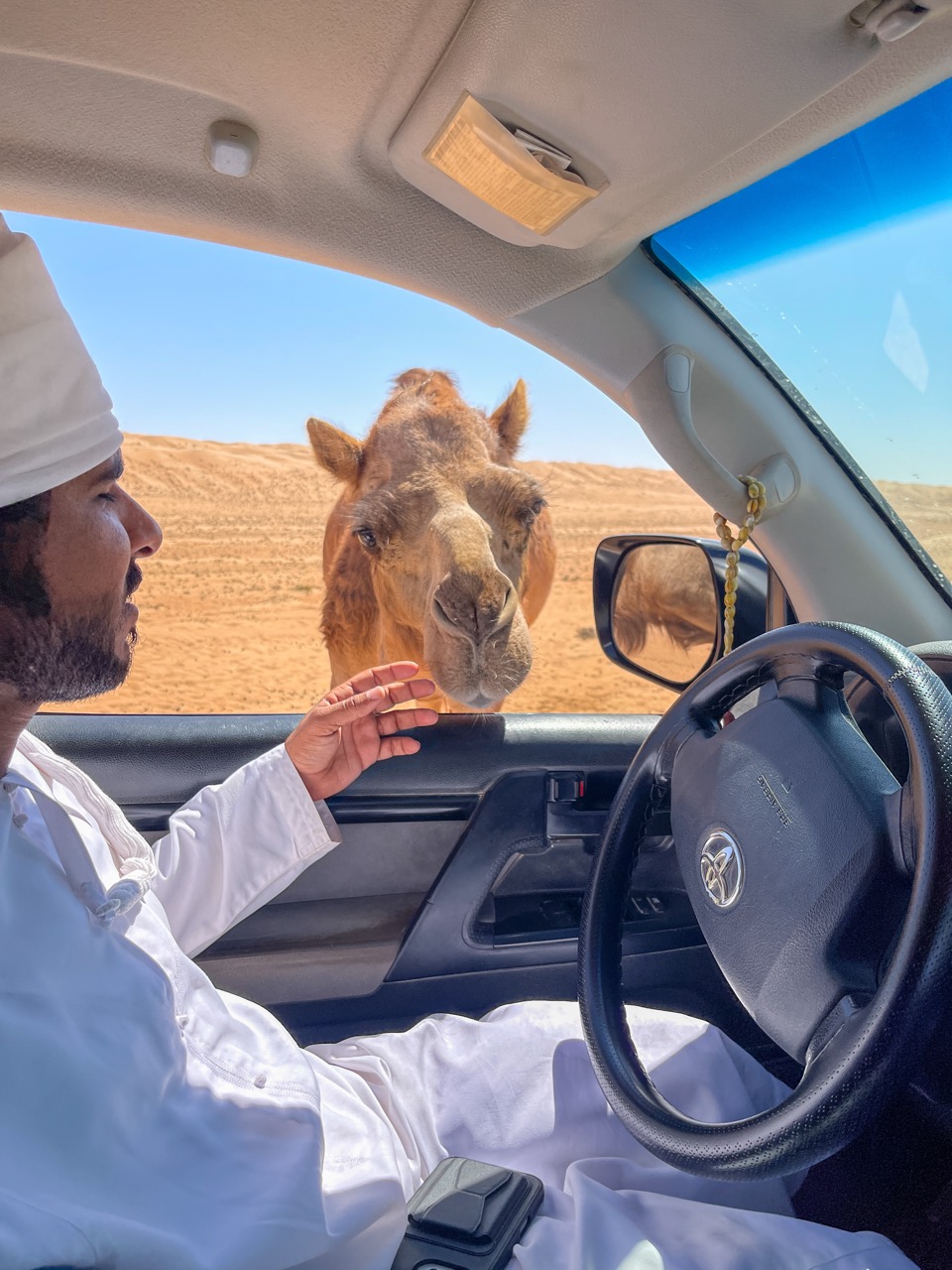
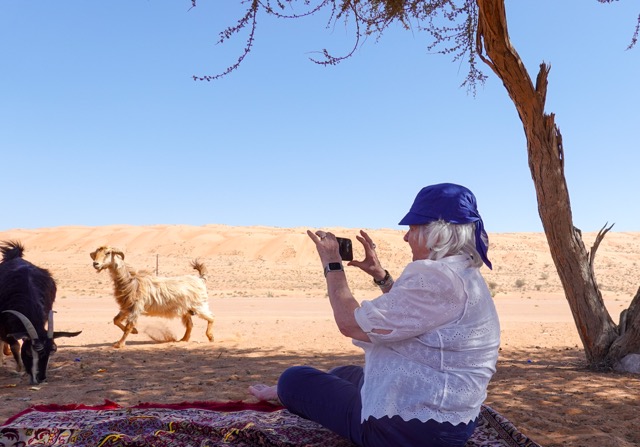
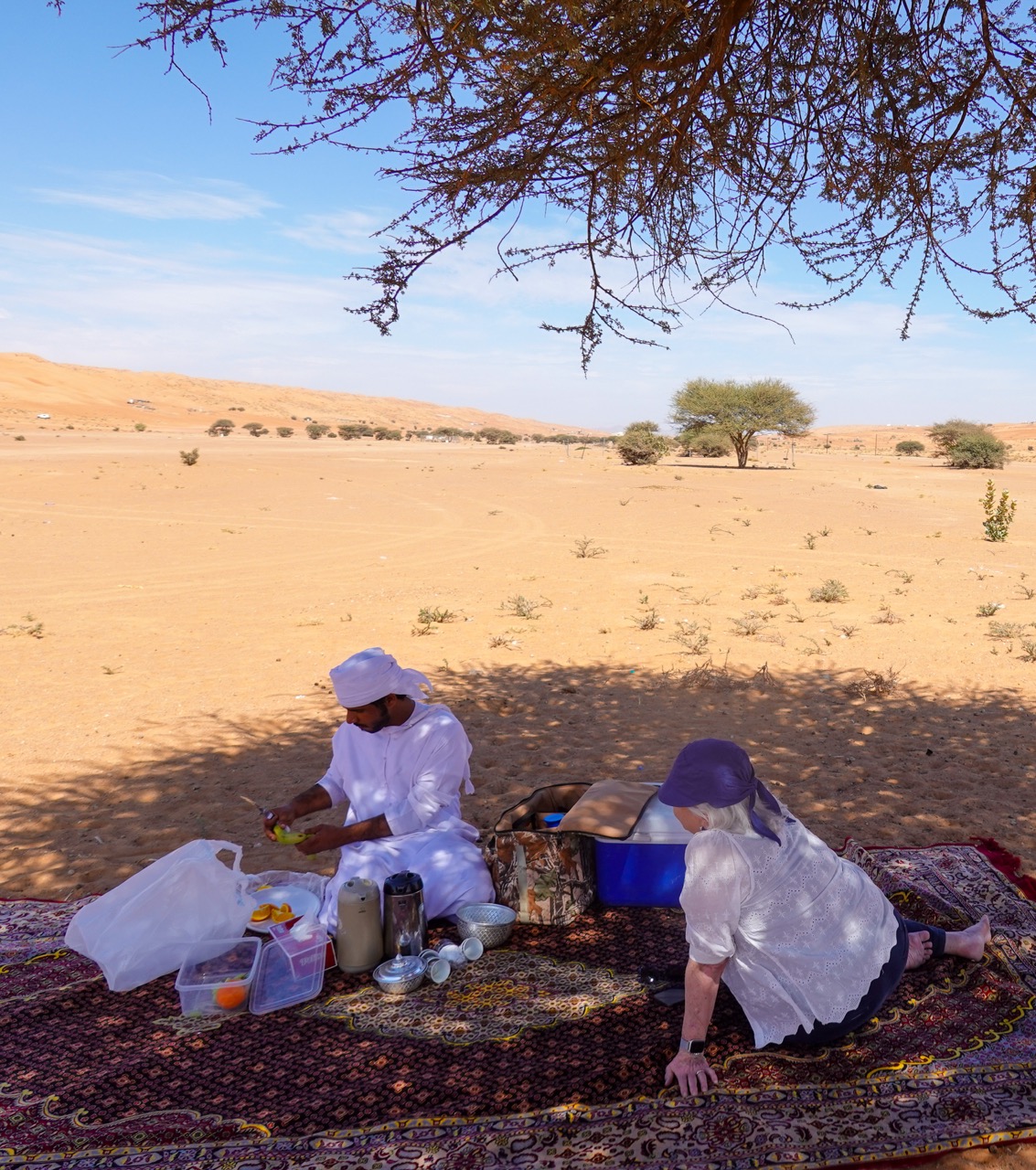
As we savored the luscious dates and sampled Muhammad’s falafel, he began telling us about his passion for camel racing. It seems that Muhammad’s family own a total of ten camels that serve a variety of functions in sustaining their lives in the desert: milk, meat, breeding, work, and the occasional special camel suitable for racing. Lest you get the wrong idea about the sophistication of this camel rearing family, Muhammad whipped out his phone to begin sharing his favorite videos of his favorite camels. The first thing that we noticed as we lounged on our carpet in the desert was that the racing camels were riderless. “Well of course,” explained Muhammad. “They are controlled remotely.” Wait, what? Remote control camels? It turns out that racing camels with riders was resulting in some pretty ugly camel mash-ups and people were getting seriously injured or killed. Solution: strap on a widget that feels like a rider to the camel but is activated with a handheld controller safely out of harms way. Seriously.
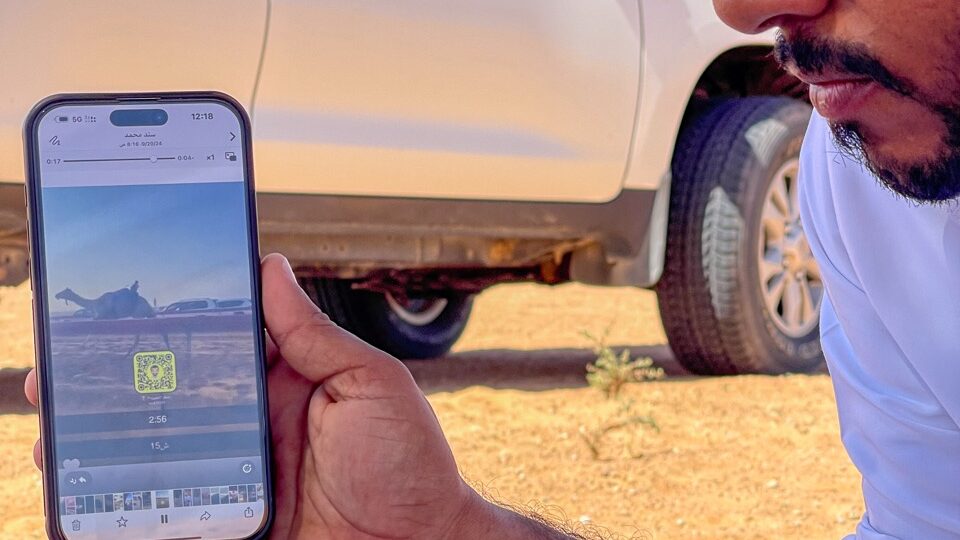
While I was beginning to ponder the wonders of accessing 5G cellular out here under our tree in the Sharqiya, Bonnie pipes up with “Muhammad? What model iPhone are you using?” “It’s a 16 Pro with a terabyte,” he replied without looking up. “What? she gasped. “I’m still carrying an iPhone 12 that runs out of battery regularly!”
And so it went at every turn. This is what a brand spanking new country looks like if you just started building it about the time the internet was invented. Qatar claims 99.7% 5G coverage of the entire country for the highest online penetration on the globe. When Bonnie got over being out teched by a desert camel racer she asked Muhammad if he might send her a few of the pictures. “No problem,” he said. “I’ll air drop them to you.” The digital world is integrated into life in Qatar and Oman at every turn. In airports, hotels, and around town, use of the highest quality technology was evident in the way everything just worked.
Not content to rest on these achievements, Qatar has created partnerships with Microsoft and Google worth billions of dollars to invest in the future development of the technology ecosystem. Quite simply, they are competing with their Arab neighbors to become the new hub of digital innovation for the future
Fit for a Sultan
Muscat sprawls along a stunningly beautiful strip of coast line, surrounded by mountains. No where is it more beautiful than at the Al Bustan Palace Hotel where we spent our last three nights in Oman. From the moment of arrival, when dates and coffee are presented in a gesture of welcome and the smell of frankincense wafts through the lobby, there is a profound sense of peace and calm. This is the world of tradition, expressed in customs and cuisine, combined with the modern world of convenience and comfort. This junction of two worlds is expressed in the famous 125 ft high lobby that glimmers with gold, polished marble, and a huge chandelier. Six glittering pools, meticulously manicured grounds, and a private beach were just the perfect way to recover from our charming tent experiences and the trauma of dune bashing.
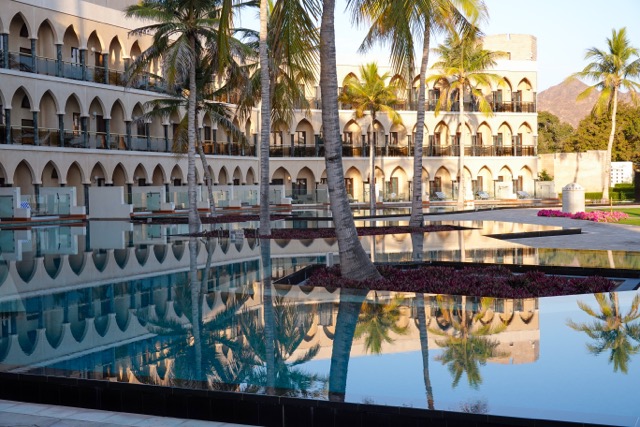
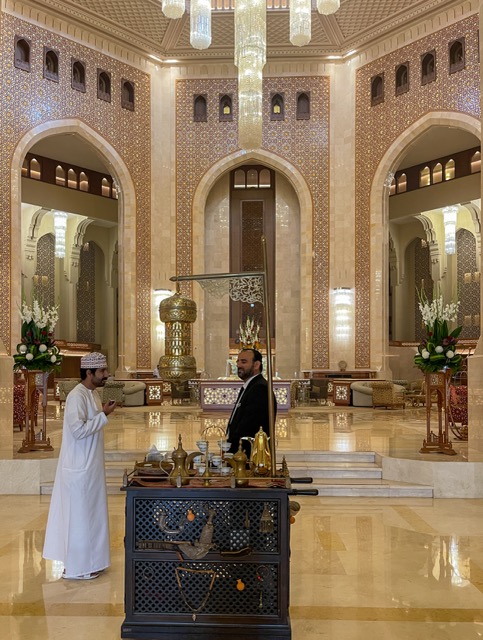
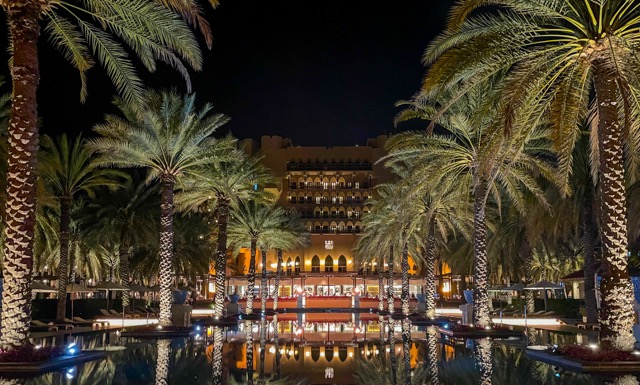
As we made our way back to the West, I couldn’t help the thought that perhaps we had been given a glimpse the future, or at least its potential.
About Us
Welcome to our little corner of the world where we invite you to embark on exciting journeys with us!
We’re Ed and Bonnie, a duo passionate about exploring the world and experiencing its wonders. Our love for travel isn’t just about discovering new places; it’s about sharing those moments with cherished family and friends like you.
Our hope is that you will feel like you’re right there with us, sharing in the excitement and wonder of each destination. Better yet, let’s plan a rendezvous somewhere wonderful! Learn more

